Tanzania is home to a diverse array of birds, with more than 1,000 species inhabiting the country’s varied landscapes.
From the snowcapped peaks of Mt. Kilimanjaro, to the lush inland wetlands, to the sandy beaches of the Indian Ocean, Tanzania’s unique geography provides a range of unique habitats for its avian inhabitants.
The country is also home to a number of endemic species, as well as migratory species who travel through the region during their seasonal migrations. We will explore the fascinating world of Tanzania’s birds and the important role they play in the country’s ecosystem.
1. Lilac-Breasted Roller
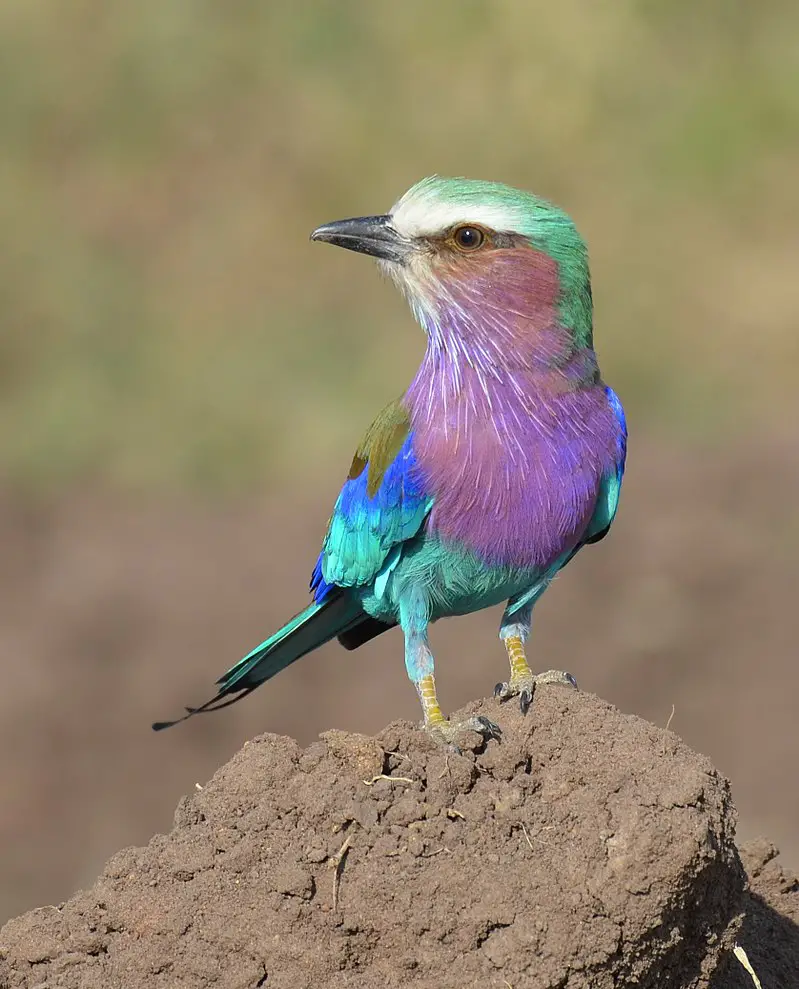
The Lilac-breasted Roller is a spectacular bird native to Southern and Eastern Africa, with occasional appearances in the southern Arabian Peninsula.
With its bright purple chest plumage and distinct black stripes on its wings and tail feathers, it stands out among birds of the same family.
It is usually found alone or in pairs perched atop trees or other high viewpoints, often used as lookout points for predators.
This species prefers open areas such as woodlands and savannas; it avoids treeless places like deserts due to their lack of protection from potential dangers.
Its call is loud and melodious – an unmistakable sound echoing through African skies.
Scientific classification:
| Kingdom | Animalia |
| Phylum | Chordata |
| Class | Aves |
| Order | Coraciiformes |
| Family | Coraciidae |
| Genus | Coracias |
| Species | C. caudatus |
Also Featured In: Famous Paintings Birds, African Birds
2. Superb Starling
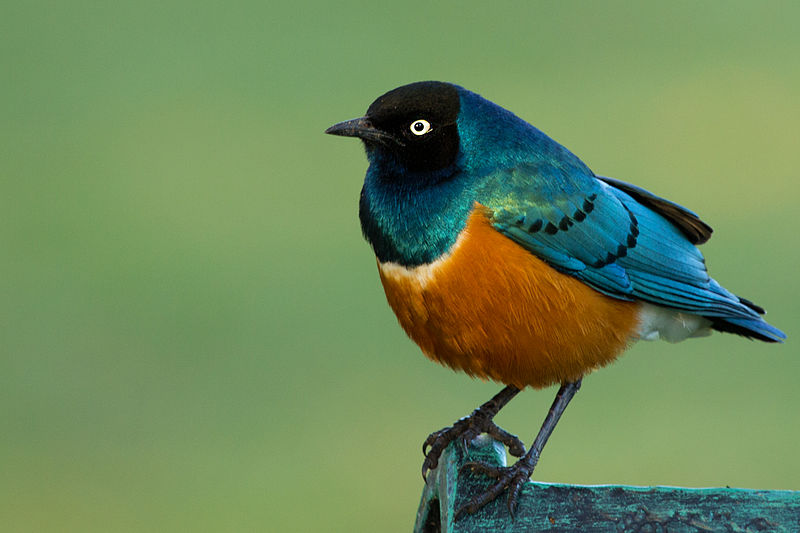
The Superb Starling is an impressive bird native to East Africa. It belongs to the starling family and was previously known as Spreo superbus.
This species can be found in Ethiopia, Somalia, Uganda, Kenya, South Sudan and Tanzania living in savanna areas with thornbush and acacia trees or near open woodlands or lakeshores.
Its plumage is mainly black with bright yellow patches on its wings while its bill is a distinctive grey-blue coloration.
The male has glossy blue feathers around his head giving him a distinguished look that stands out from other birds of this type.
In addition they possess long tails which make them great gliders when soaring through their habitats looking for food such as insects, crops or small animals like frogs and lizards to eat.
Scientific classification:
| Kingdom | Animalia |
| Phylum | Chordata |
| Class | Aves |
| Order | Passeriformes |
| Family | Sturnidae |
| Genus | Lamprotornis |
| Species | L. superbus |
Also Featured In: Savanna Birds You Need to See, Birds You’ll Find in Kenya Safari
3. Kori Bustard
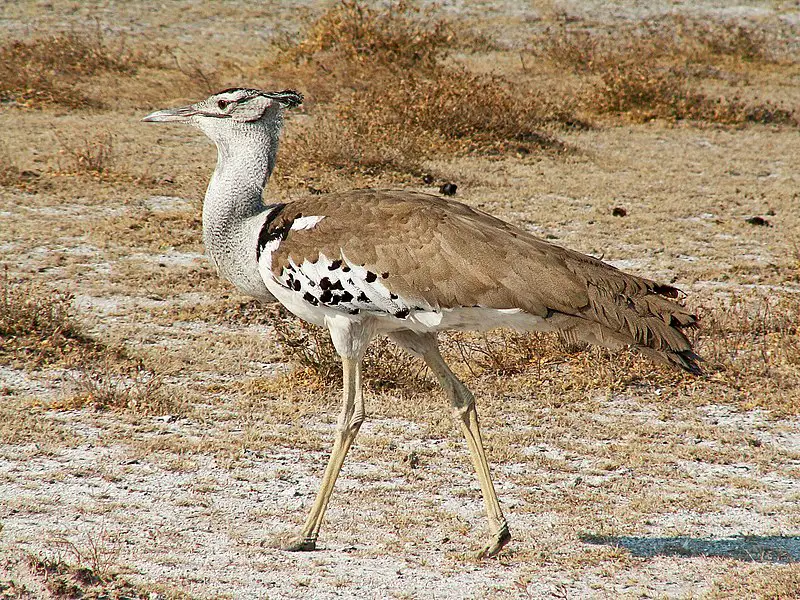
The Kori Bustard is the largest flying bird native to Africa and part of the bustard family. It has a large body, with males reaching up to 20kg in weight – making it one of the heaviest living animals capable of flight.
Its range covers most African countries from Ethiopia all the way down south towards South Africa.
The Kori Bustard is omnivorous and feeds on insects, small lizards, seeds, fruit and even carrion if available.
Their feathers are mostly brownish grey while their heads have black stripes running over them which makes them easily identifiable when seen in its natural habitat.
They usually live alone or in pairs during breeding season but will gather into larger groups at other times throughout their lives; typically nesting on dry open grasslands near water sources for easy access to food and drink.
Scientific classification:
| Kingdom | Animalia |
| Phylum | Chordata |
| Class | Aves |
| Order | Otidiformes |
| Family | Otididae |
| Genus | Ardeotis |
| Species | A. kori |
Also Featured In: East African Birds, Birds that You’ll Find in Kruger national park
4. Hamerkop
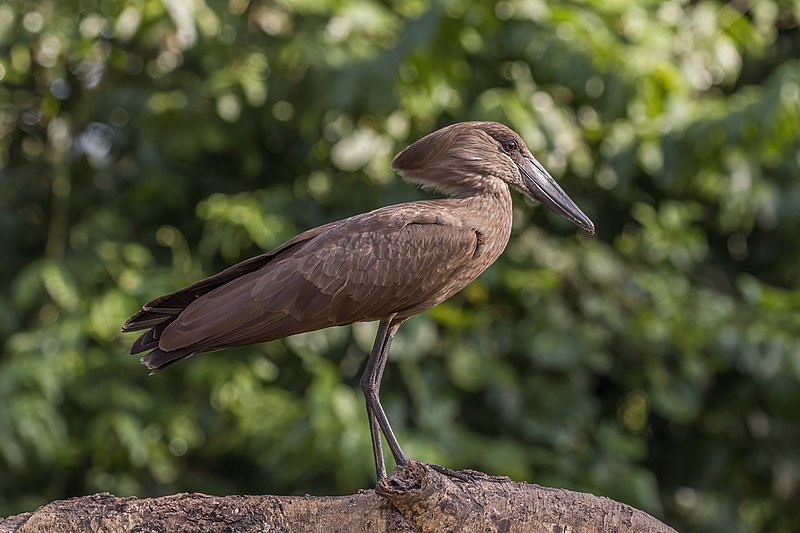
The Hamerkop is a unique wading bird found across sub-Saharan Africa and as far east as India.
It has an unmistakable silhouette, with its long bill topped by a crest at the back of its head that gives it the look of a hammerhead shark.
Its plumage consists mainly of browns and greys, providing excellent camouflage in reed beds.
The species was once classified alongside storks but is now believed to be closely related to pelicans and shoebills instead.
This medium-sized bird feeds on insects, fish, frogs or small reptiles which it captures from shallow water or plucks from trees near bodies of water.
Despite being considered ‘unlucky’ by some cultures due to superstition surrounding their appearance they are actually quite important for controlling populations of certain pests.
Scientific classification:
| Kingdom | Animalia |
| Phylum | Chordata |
| Class | Aves |
| Order | Pelecaniformes |
| Family | Scopidae |
| Genus | Scopus |
| Species | S. umbretta |
5. Tawny Eagle
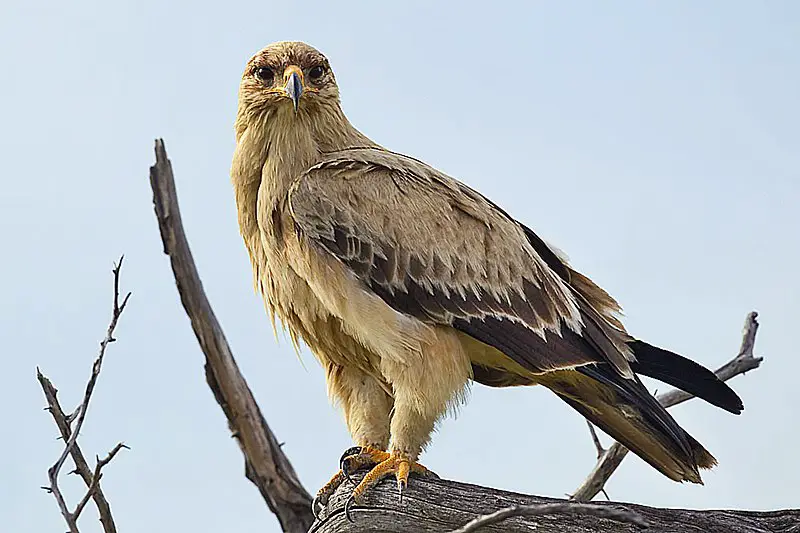
The tawny eagle is a majestic bird of prey that can be found across much of Africa, the Indian subcontinent and rare parts of southern Europe.
It belongs to the Accipitridae family, within the Aquilinae or “booted eagles” subfamily due to its heavily feathered legs.
They have brown plumage with paler underparts which gives them their namesake tawny colouring.
With long wingspans they soar gracefully over open grasslands and deserts in search of small mammals such as hares, rodents and birds for food.
Their loud squawks echo across their habitats while they use powerful talons to snatch up unsuspecting animals below them before enjoying their meal on an exposed perch high above ground level.
Scientific classification:
| Kingdom | Animalia |
| Phylum | Chordata |
| Class | Aves |
| Order | Accipitriformes |
| Family | Accipitridae |
| Genus | Aquila |
| Species | A. rapax |
Also Featured In: Large African Birds You Need to Know, Big Birds that Live in Uganda
6. Silvery-Cheeked Hornbill
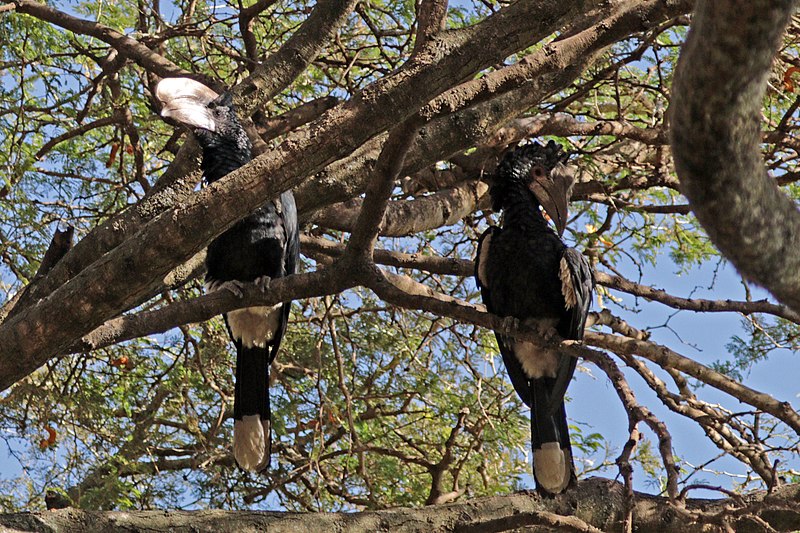
The silvery-cheeked hornbill is a beautiful species of bird native to East Africa. It stands out in its habitat due to its large size and striking features, including bright yellow eyes and white cheek patches on either side of the head.
This impressive creature can be found inhabiting tall evergreen forests from Ethiopia all the way down to South Africa.
Unfortunately, it’s becoming threatened as deforestation destroys more areas that are suitable for nesting sites.
Despite this threat, these birds remain fairly common throughout Zimbabwe and northern/central parts of South Africa – however their presence there is marginal at best.
We must work together now if we want future generations to have the chance appreciate these magnificent creatures.
Scientific classification:
| Kingdom | Animalia |
| Phylum | Chordata |
| Class | Aves |
| Order | Bucerotiformes |
| Family | Bucerotidae |
| Genus | Bycanistes |
| Species | B. brevis |
Also Featured In: Silver Birds You Should Know,
7. Mousebird
The Mousebird is a unique bird found in tropical and subtropical Africa. It has an unusual shape, being long-tailed with short wings and a small head. Its tail feathers are greyish-brown while its body ranges from deep blue to light brown or black depending on the species.
The most common feature of these birds is their distinctive call which sounds like ‘chirp chirp’ hence giving them their nickname – mousebirds.
They feed mainly on fruit, flowers, leaves and insects but will also eat eggs if given the chance. Mousebirds form large flocks that can often be seen flying low over fields searching for food items.
These lively little creatures make wonderful aviary pets as they are very social animals who love interacting with people in addition to other mice birds within the group.
8. Rufous-Tailed Weaver
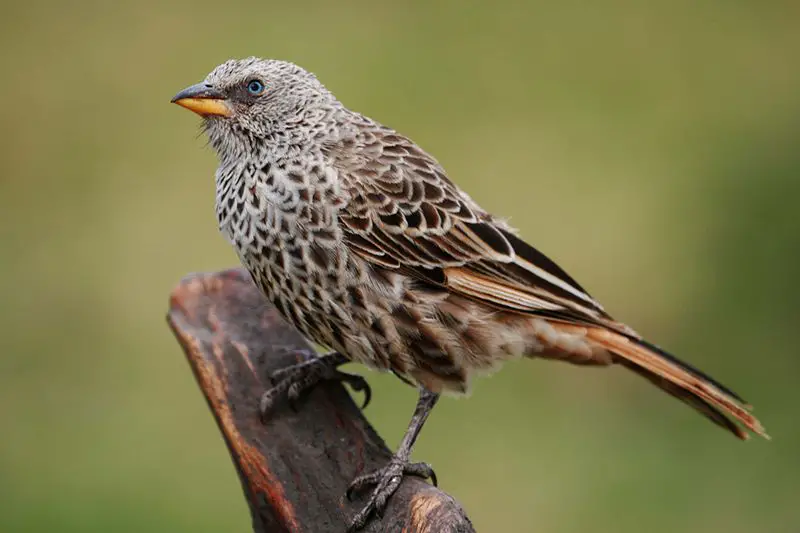
The Rufous-tailed Weaver is a small songbird native to East Africa. It belongs to the weaver family Ploceidae, although many authors have included it in the Old World Sparrow family Passeridae.
This bird has an unmistakable appearance with its rufous tail and buffy head coloration. Its short bill is strong for cracking seeds, which makes up much of their diet during breeding season.
They prefer open woodlands and savannahs where they build basket-like nests hanging from trees or shrubs that are lined with grasses and other vegetation material as well as feathers from other birds species if available.
The Rufous-tailed Weaver lives mainly in Tanzania but can be found as far north as Kenya on occasion due to seasonal migration patterns and vagrancy behavior.
Scientific classification:
| Kingdom | Animalia |
| Phylum | Chordata |
| Class | Aves |
| Order | Passeriformes |
| Family | Ploceidae |
| Genus | Histurgops Reichenow, 1887 |
| Species | H. ruficauda |
9. Yellow-Billed Stork
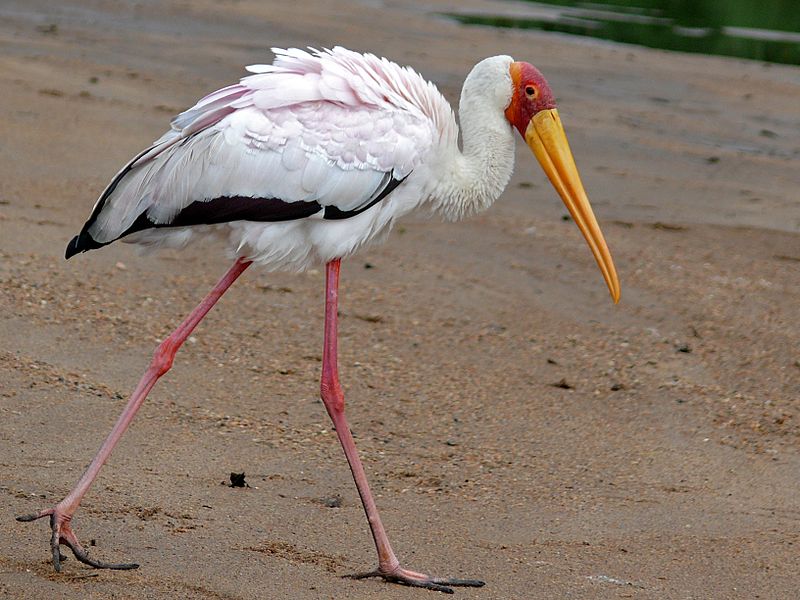
The yellow-billed stork is a large wading bird found in Africa south of the Sahara as well as Madagascar.
It belongs to the family Ciconiidae and has three other species in its genus – Mycteria americana, Mycteria cinerea and Leptoptilos javanicus.
This majestic bird stands at an average height of up to 1 meter with a wingspan that can reach 2 meters wide.
Its plumage is predominantly white with black flight feathers that contrast against its bright yellow bill for which it is named after.
The Yellow-billed Stork feeds on fish, frogs, insects and small reptiles like snakes by probing deep into mud or shallow water bodies using its long beak.
These captivating birds are also known to form colonies during their nesting season from August until October where they build nests out of sticks atop tall trees near wetlands or riversides.
Scientific classification:
| Kingdom | Animalia |
| Phylum | Chordata |
| Class | Aves |
| Order | Ciconiiformes |
| Family | Ciconiidae |
| Genus | Mycteria |
| Species | M. ibis |
Also Featured In: Fuerteventura Island Birds You Need to See,
10. Black Heron
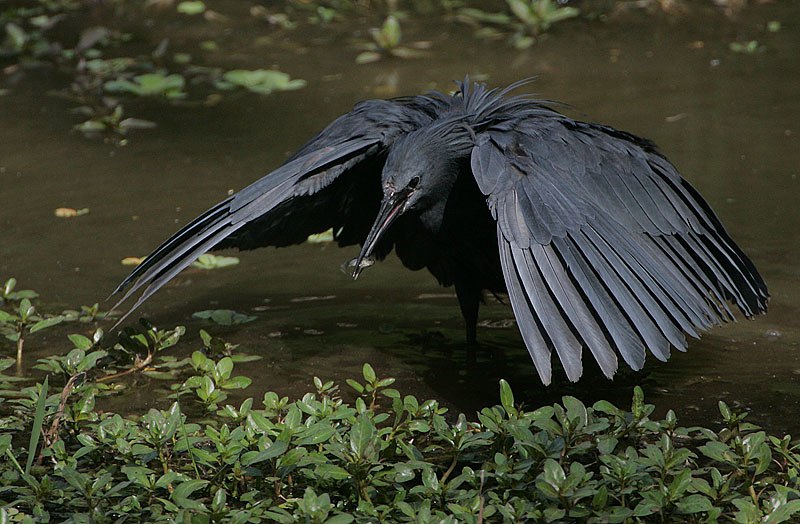
The Black heron is a majestic bird found mainly in Africa. It stands at an average height of 42.5-66 cm and has black plumage with a yellow beak, lores and feet.
During breeding season it grows long plumes on its crown giving it an exquisite appearance; this is also the time when their wings form a canopy while they fish which makes them easily recognizable from other birds.
Seeing as they occur patchily throughout sub Saharan Africa, South Asia and Madagascar, there are various conservation efforts to protect this species from extinction due to habitat destruction or illegal hunting for feathers/meat.
Scientific classification:
| Kingdom | Animalia |
| Phylum | Chordata |
| Class | Aves |
| Order | Pelecaniformes |
| Family | Ardeidae |
| Genus | Egretta |
| Species | E. ardesiaca |
11. Yellow-Collared Lovebird
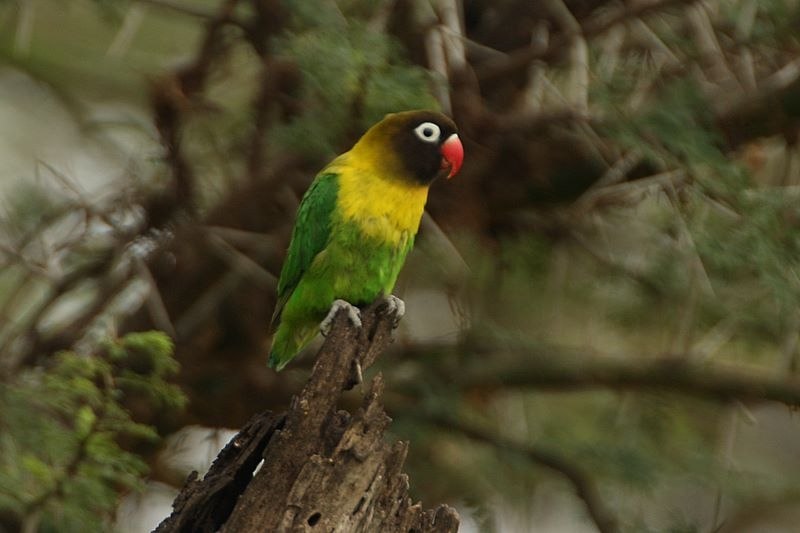
The Yellow-collared Lovebird is native to the Arusha Region of Tanzania. These small birds are known for their bright yellow collars, black masks and striking red eyes.
They have an average wingspan of 9 inches (23 cm) and weigh only 2 ounces (60 g). This species has been introduced to Burundi and Kenya as well, with some sightings reported in Puerto Rico too.
While they are mainly found in grasslands or savannahs, they can often be seen perching on trees or shrubs near water sources such as rivers or lakes. The diet consists mainly of fruits and seeds but also includes insects like spiders and beetles from time to time.
In captivity, these lovebirds need plenty of space so that they can stretch out their wings properly; a cage size no smaller than 3 feet by 18” should do nicely.
Scientific classification:
| Kingdom | Animalia |
| Phylum | Chordata |
| Class | Aves |
| Order | Psittaciformes |
| Family | Psittaculidae |
| Genus | Agapornis |
| Species | A. personatus |
12. Northern Red-Billed Hornbill
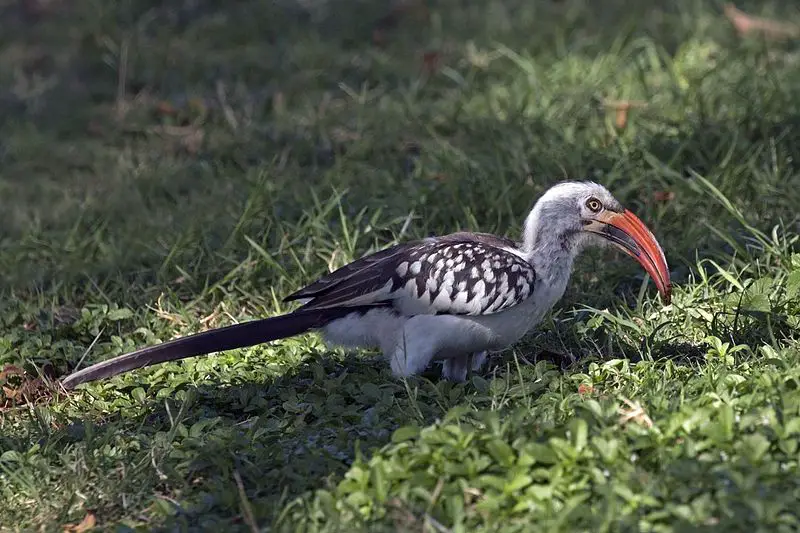
The Northern Red-billed Hornbill is a species of bird belonging to the Bucerotidae family. It can be found in many countries across Africa, from Mauritania through Somalia and Northeast Tanzania.
This hornbill has five recognized subspecies, though all were once considered part of one single species. The northern red-billed hornbill have distinctive black feathers on their body with deep yellow around its eyes and crest.
Its bill and legs are bright red while they feature an impressive casque at the top of it’s head that helps amplify calls during mating season or as a signifier for territoriality towards other birds.
They feed mainly on fruits such as figs but also enjoy insects like moths or beetles when available.
Scientific classification:
| Kingdom | Animalia |
| Phylum | Chordata |
| Class | Aves |
| Order | Bucerotiformes |
| Family | Bucerotidae |
| Genus | Tockus |
| Species | T. erythrorhynchus |
13. Common Scimitarbill
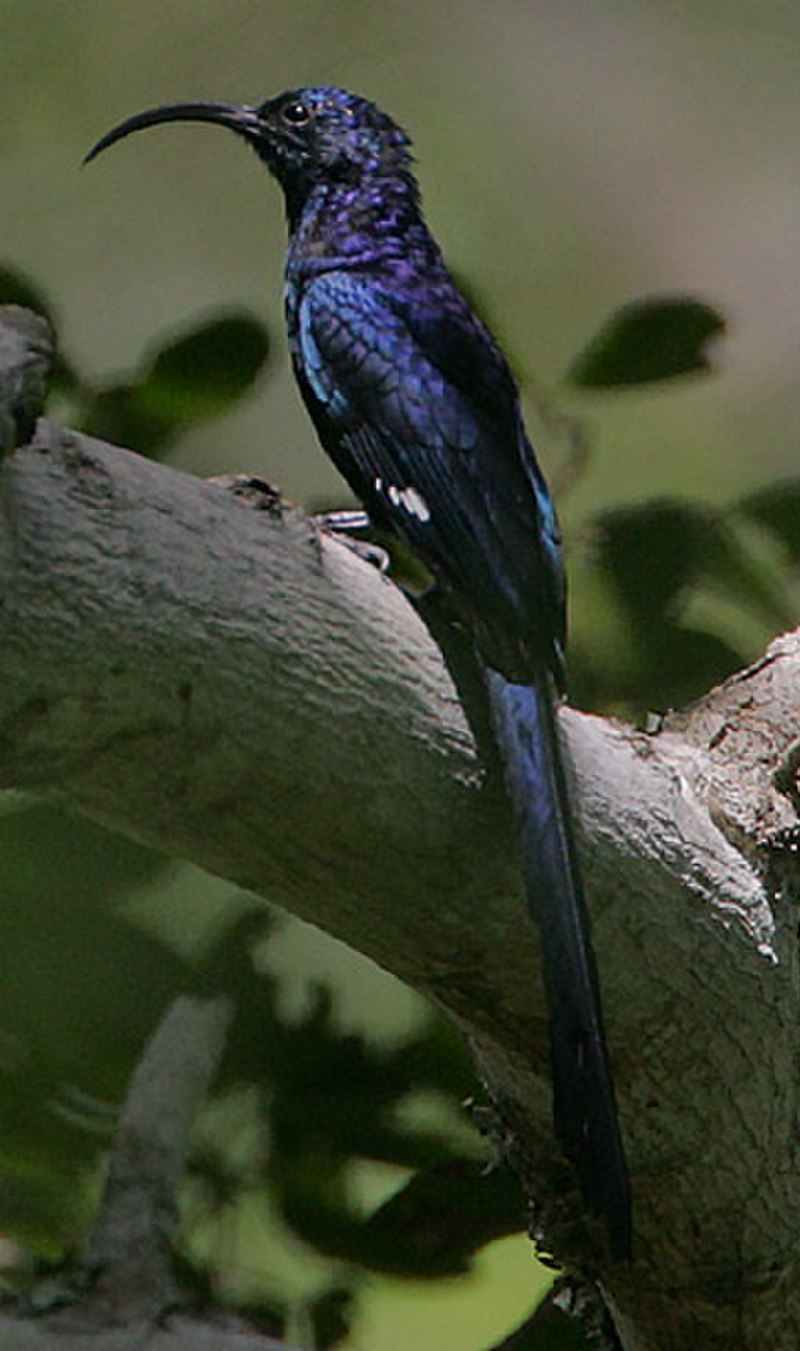
The Common scimitarbill is a species of bird found in many African countries. It has dark blue plumage and a characteristic long, curved beak that distinguishes it from other birds.
The colour of the beak changes with age: juveniles have grey beaks while adults possess black ones.
This attractive bird inhabits dry woodlands, savannahs and grassland areas where they search for food such as insects on the ground or low-lying vegetation using their long bill to probe into crevices.
They may also form small flocks which are known to follow antelope herds due to their abundance of potential prey items disturbed by movement through thick bushveld habitat types.
Scientific classification:
| Kingdom | Animalia |
| Phylum | Chordata |
| Class | Aves |
| Order | Bucerotiformes |
| Family | Phoeniculidae |
| Genus | Rhinopomastus |
| Species | R. cyanomelas |
14. African Jacana
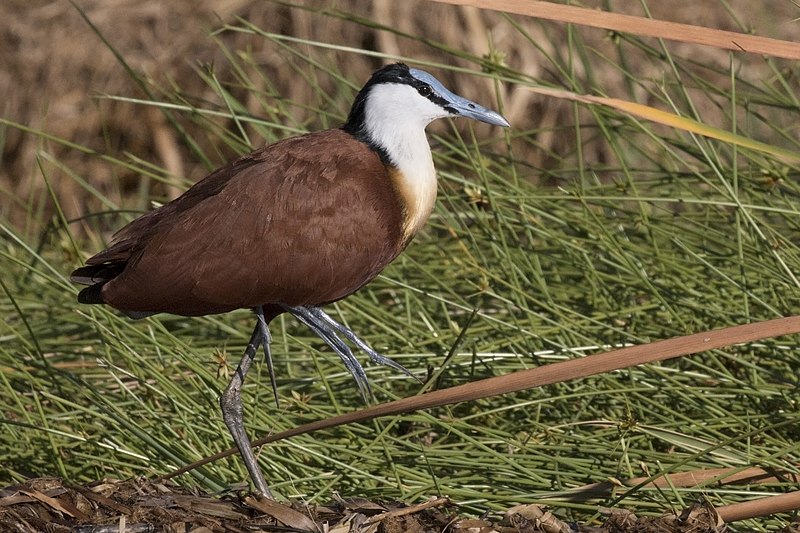
The African Jacana is a charming wader belonging to the family of Jacanidae, mostly found in sub-Saharan Africa.
It has long toes and claws that allow it to walk on floating vegetation in shallow lakes which form its preferred habitat.
The bird was officially described by Johann Friedri in 1789 with an interesting origin and pronunciation for its name -Jacanidae.
This aquatic bird is known for its striking plumage features like yellow crowns and black wings marked with chestnut brown stripes across them, making them look even more attractive when they spread their wing feathers during courtship displays.
They feed mainly on insects, tadpoles, frogs etc., skimming nearby water surface or plucking prey from vegetation as they wander around these wetlands areas.
Scientific classification:
| Kingdom | Animalia |
| Phylum | Chordata |
| Class | Aves |
| Order | Charadriiformes |
| Family | Jacanidae |
| Genus | Actophilornis |
| Species | A. africanus |
Also Featured In: Birds of Côte d’Ivoire,
15. Grey-Headed Kingfisher
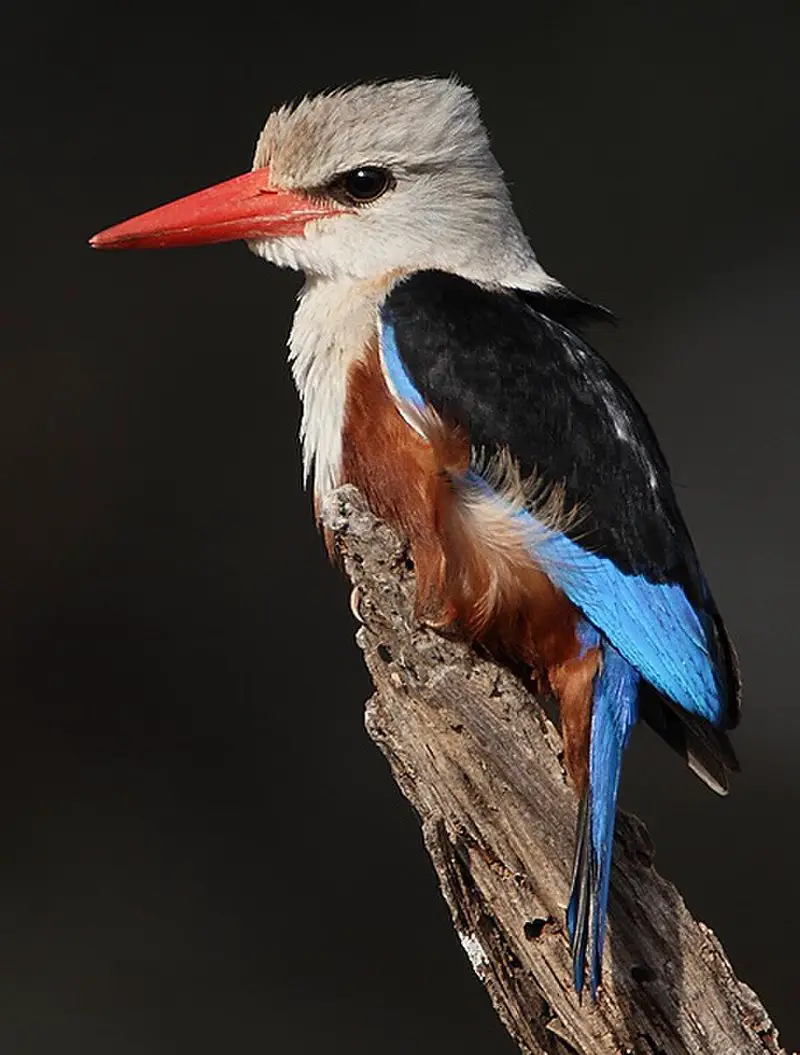
The Grey-headed Kingfisher is a stunning species of kingfisher that can be found across much of Africa and the Middle East. Its striking grey head, white neck, black back and wings with blue speckles make it an instantly recognizable bird.
It has been described formally by German zoologist Philipp Ludwig Statius Müller since 17.
This small but beautiful predator feeds mainly on insects such as beetles, grasshoppers and cicadas which they catch while hovering over water or in flight from perches up to 20 meters above ground level.
They are monogamous birds who will form lifelong pair bonds during mating season when males display courtship behavior including tail fanning and bill clacking displays at their chosen mate’s nest site.
These little birds play an important part in African ecosystems so we should all take care to preserve them for future generations.
Scientific classification:
| Kingdom | Animalia |
| Phylum | Chordata |
| Class | Aves |
| Order | Coraciiformes |
| Family | Alcedinidae |
| Subfamily | Halcyoninae |
| Genus | Halcyon |
| Species | H. leucocephala |
16. Yellow-Necked Spurfowl
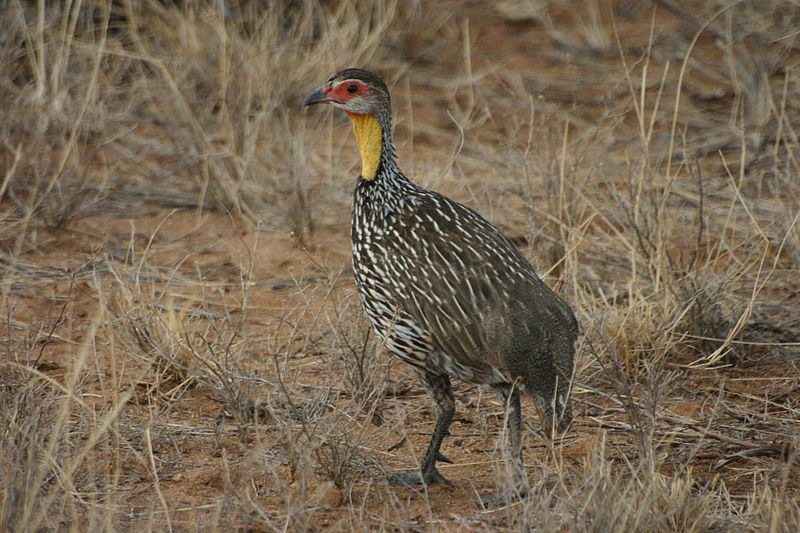
The Yellow-necked Spurfowl is a species of bird in the Phasianidae family, found across East Africa. They are easily identifiable by their yellow patch on the neck and males have spurs located at the back of their legs.
This species was first described in 1851 after it was discovered inhabiting various areas including Djibouti, Eritrea, Ethiopia, Kenya Somalia Sudan Tanzania and Uganda.
It has since become quite rare due to over hunting for food as well as habitat destruction caused by human activity such as deforestation.
Despite this ongoing threat they still remain relatively common within some regions particularly those with better protection from humans like wildlife reserves or national parks where they can live undisturbed amongst other animals living there too.
Scientific classification:
| Kingdom | Animalia |
| Phylum | Chordata |
| Class | Aves |
| Order | Galliformes |
| Family | Phasianidae |
| Genus | Pternistis |
| Species | P. leucoscepus |
17. Pel’s Fishing Owl
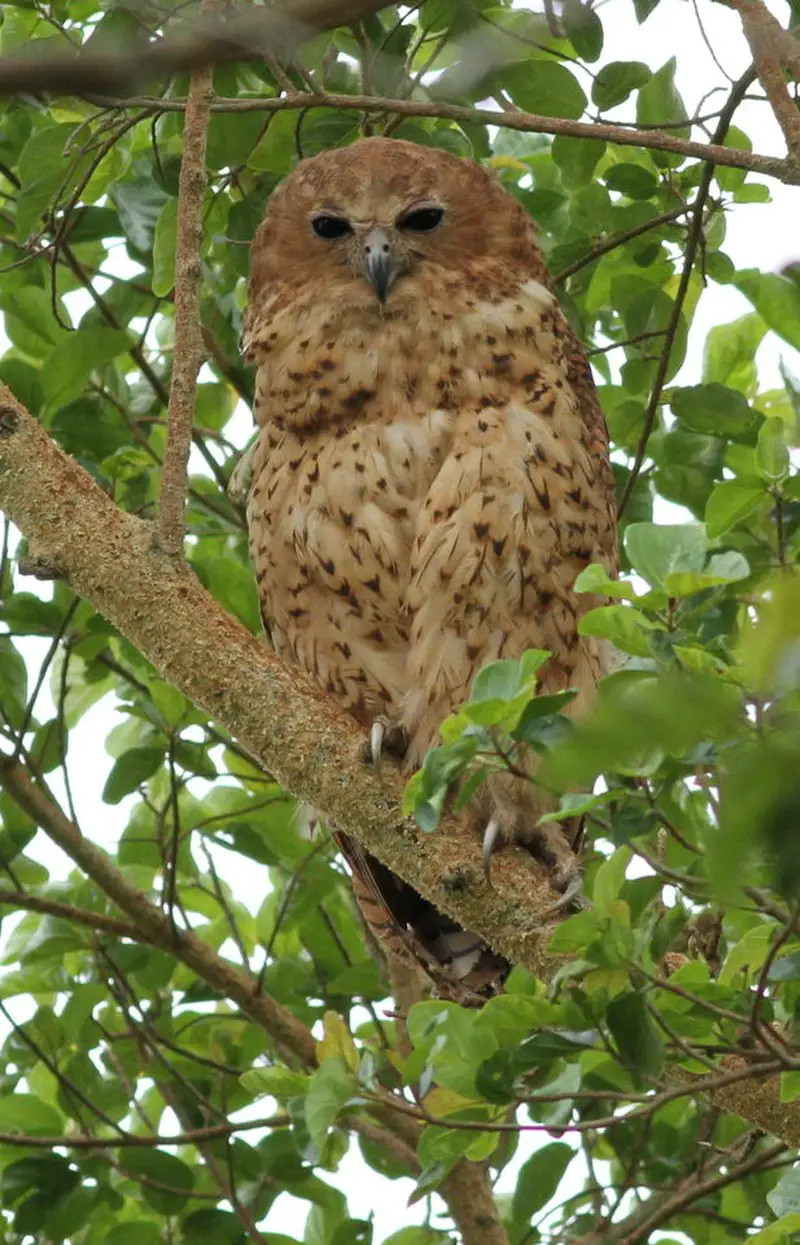
Pel’s fishing owl is a large species of Strigidae found in Africa. It hunts mainly at night, snatching up fish and frogs from rivers and lakes with its sharp talons.
They prefer slow-moving waterways with lots of overhanging trees so they can roost during the day or hunt for prey without being seen.
The owls nest in hollows or forks of large trees to stay safe from predators.
Even though there are many threats that put these birds at risk, conservation efforts have helped secure their population numbers for now.
Scientific classification:
| Kingdom | Animalia |
| Phylum | Chordata |
| Class | Aves |
| Order | Strigiformes |
| Family | Strigidae |
| Genus | Scotopelia |
| Species | S. peli |
18. African Marsh Harrier
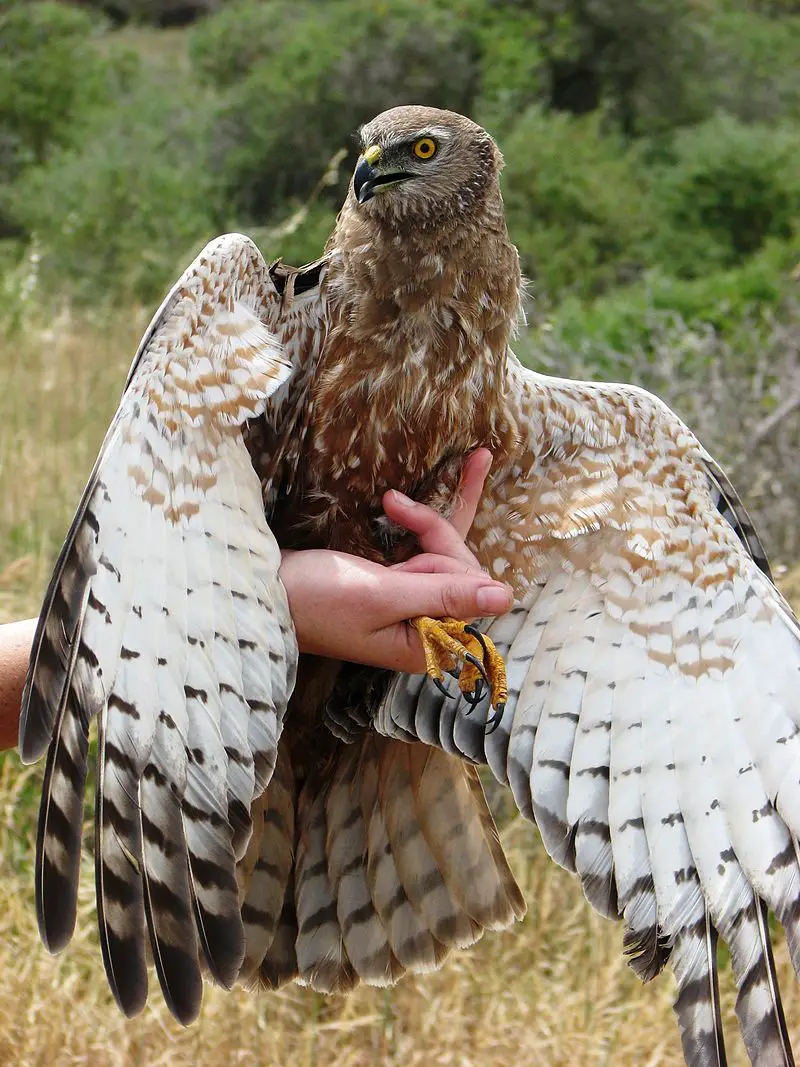
The African Marsh Harrier is an impressive bird of prey belonging to the harrier genus Circus. It inhabits wetland habitats in Southern, Central and Eastern Africa from South Sudan all the way down to South Africa.
The female birds are larger than males with a length of 44-47 centimeters (17-19 inches) and weighing about 30% heavier than their male counterparts.
These majestic creatures have striking features such as yellow eyes, grey wings and white patches on its back while they soar through the skies above these wetlands hunting for small animals like amphibians, reptiles or rodents that make up their diet.
With careful conservation efforts this species can continue thrive across it’s natural habitat range.
Scientific classification:
| Kingdom | Animalia |
| Phylum | Chordata |
| Class | Aves |
| Order | Accipitriformes |
| Family | Accipitridae |
| Genus | Circus |
| Species | C. ranivorus |
19. Vitelline Masked Weaver
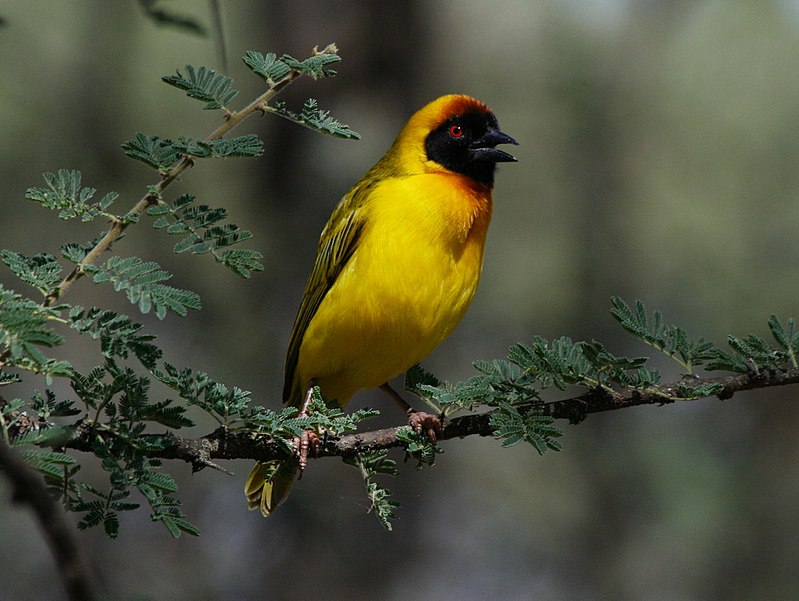
The Vitelline masked weaver is a species of bird belonging to the family Ploceidae. This bird can be found in western, central and eastern Africa.
Males have light-brown heads with dark streaks on each side and black patches around their eyes that gives them an appearance of wearing masks – hence the name ‘masked weaver’.
The males also have bright yellow underparts while females are duller brown all over. Both sexes build nests using reeds or grasses which they weave together into cup shapes suspended from branches high off the ground.
They are highly social creatures often seen gathering near water sources such as rivers or lakes in groups of up to 20 individuals busily foraging for food before retreating back home at nightfall.
Scientific classification:
| Kingdom | Animalia |
| Phylum | Chordata |
| Class | Aves |
| Order | Passeriformes |
| Family | Ploceidae |
| Genus | Ploceus |
| Species | P. vitellinus |
20. Black-Headed Heron
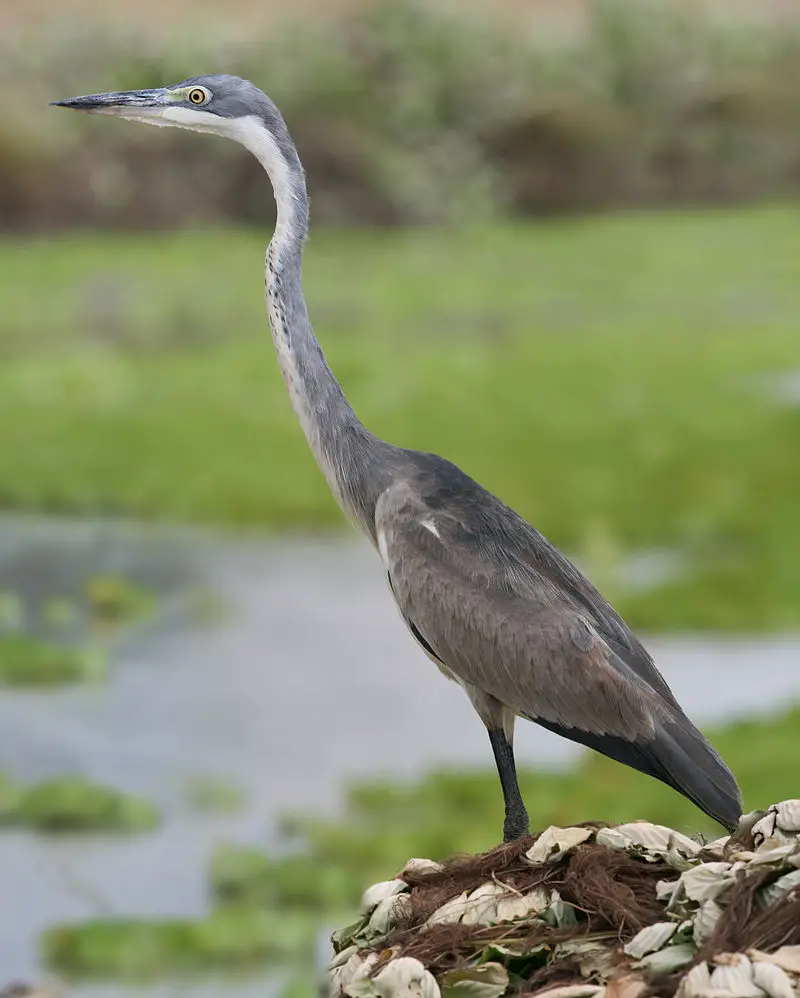
The Black-headed Heron is a wading bird from the heron family Ardeidae, found in sub-Saharan Africa and Madagascar.
It typically resides in wetland areas such as reedbeds or swamps but some birds migrate further north during rainy seasons.
Breeding usually takes place between two to four eggs laid within a bulky stick nest built by both parents.
The Black-headed Heron feeds mainly on small fish, crustaceans and other aquatic organisms which it catches with its long bill while standing still at water’s edge or slowly moving around shallow waters.
Its feathers are usually mostly white apart from the black head for which this species has been named after and grey wings with distinctive dark patches near shoulder area giving them an attractive appearance when seen up close.
Scientific classification:
| Kingdom | Animalia |
| Phylum | Chordata |
| Class | Aves |
| Order | Pelecaniformes |
| Family | Ardeidae |
| Genus | Ardea |
| Species | A. melanocephala |
Also Featured In: Birds that Ngorongoro Crater,
21. Pemba Scops Owl
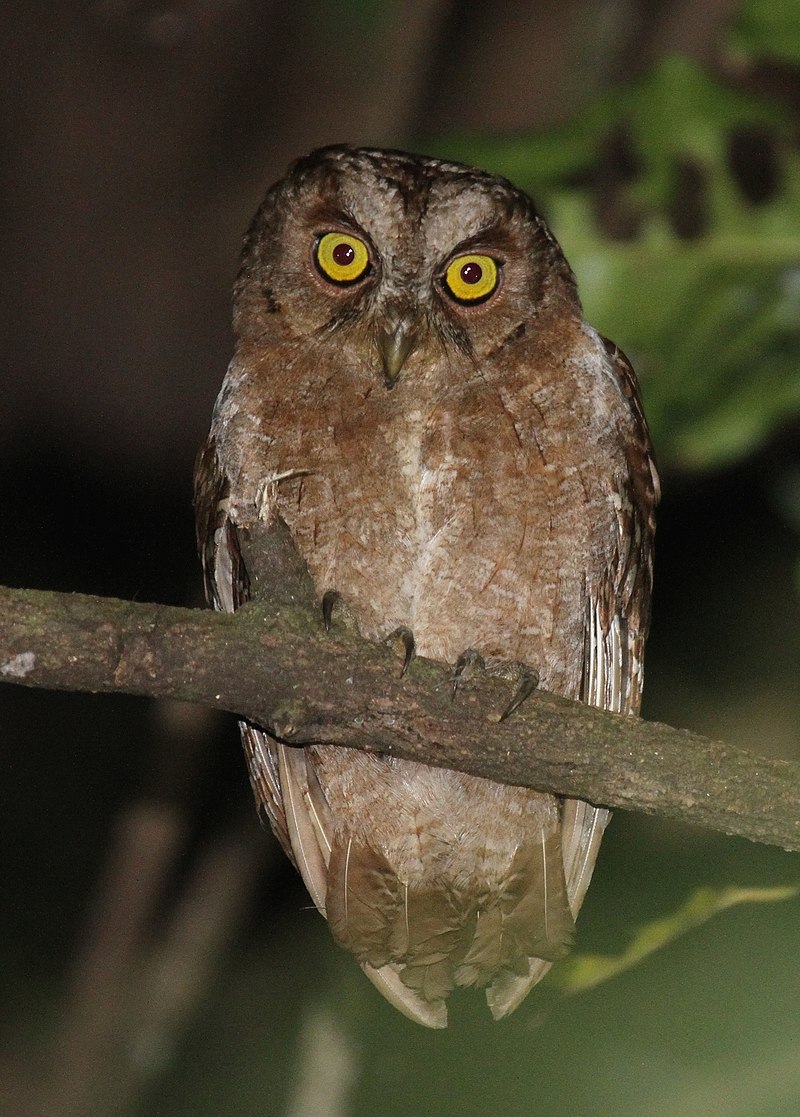
The Pemba scops owl is a species of bird found only on the island of Pemba, Tanzania. It is part of the family Strigidae and was formerly regarded as a subspecies of the Madagascar scops owl due to morphological similarities.
However, recent genetic research has shown that it is more closely related to African Scops Owls. The Pemba Owl can be identified by its yellow eyes and brownish-gray plumage with white spots across its wings and body.
Its call consists mainly of two distinct notes which are repeated twice in sequence before ending abruptly or merging into another note structure known as ‘trill’.
This species primarily feeds on insects such as moths, beetles and crickets but also eats small rodents if available.
Conservation efforts have been made for this rare endemic species including habitat protection measures like establishing wildlife reserves in order to ensure their survival against threats from deforestation, hunting pressure and agricultural expansion activities.
Scientific classification:
| Kingdom | Animalia |
| Phylum | Chordata |
| Class | Aves |
| Order | Strigiformes |
| Family | Strigidae |
| Genus | Otus |
| Species | O. pembaensis |
22. Jacanas
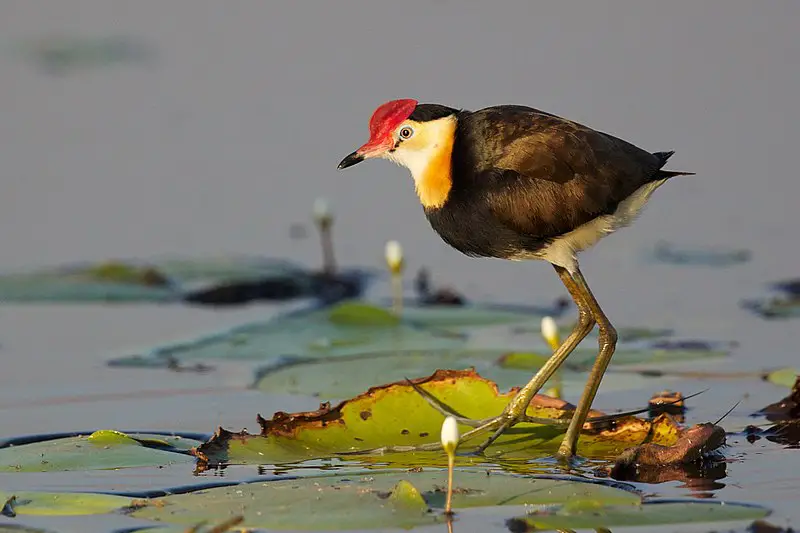
Jacanas are tropical waders belonging to the Jacanidae family. They have distinctive elongated toes and toenails which help them forage on floating or semi-emergent aquatic vegetation.
This adaptation gives them their nickname “Jesus birds” as they seem to be able to walk on water.
The female jacanas are also unique amongst bird species in that they take charge of nest building, incubation and caring for young while males perform courtship displays.
These unusual birds can be found throughout the world’s tropical regions where they inhabit wetlands such as swamps, marshes and shallow lakes with lily pads.
With a wide variety range due their special adaptations these beautiful creatures will surely continue living life at ease around our planet’s warmest waters.
Scientific classification:
| Kingdom | Animalia |
| Phylum | Chordata |
| Class | Aves |
| Order | Charadriiformes |
| Suborder | Thinocori |
| Family | Jacanidae Stejneger, 1885 |
23. Pygmy Falcon
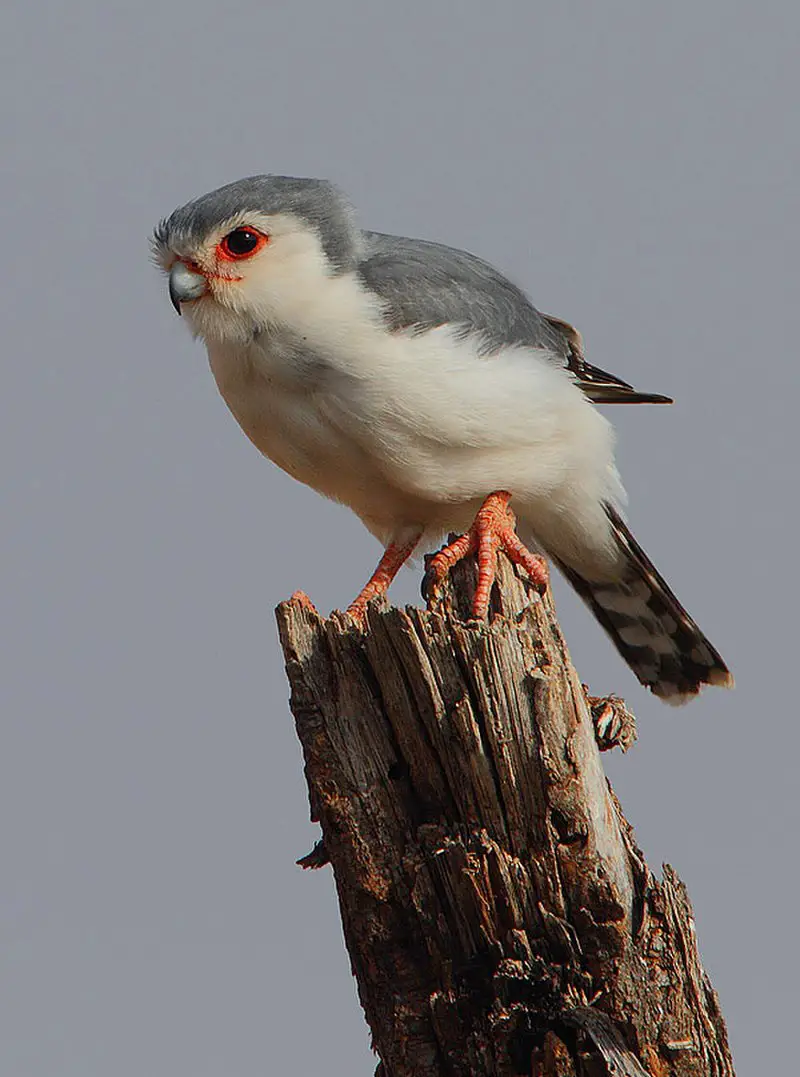
The Pygmy Falcon is a small bird of prey native to eastern and southern Africa. It stands out in its environment due to its diminutive size, being the smallest species of raptor on the continent.
Adults have white bellies, grey backs, chestnut coloured back for females and white “eye spots” at their nape. Juveniles are brown with a rufous wash on their wings and tail feathers.
These birds can be seen hunting smaller animals such as lizards or insects during daylight hours but also hunt in pairs at night when they focus mainly on rodents and bats that roost near tree branches close to ground level.
The Pygmy Falcon plays an important role in maintaining ecological balance by controlling populations of mammalian pests which helps local farmers protect their crops from destruction.
Scientific classification:
| Kingdom | Animalia |
| Phylum | Chordata |
| Class | Aves |
| Order | Falconiformes |
| Family | Falconidae |
| Genus | Polihierax |
| Species | P. semitorquatus |
24. Fischer’s Turaco
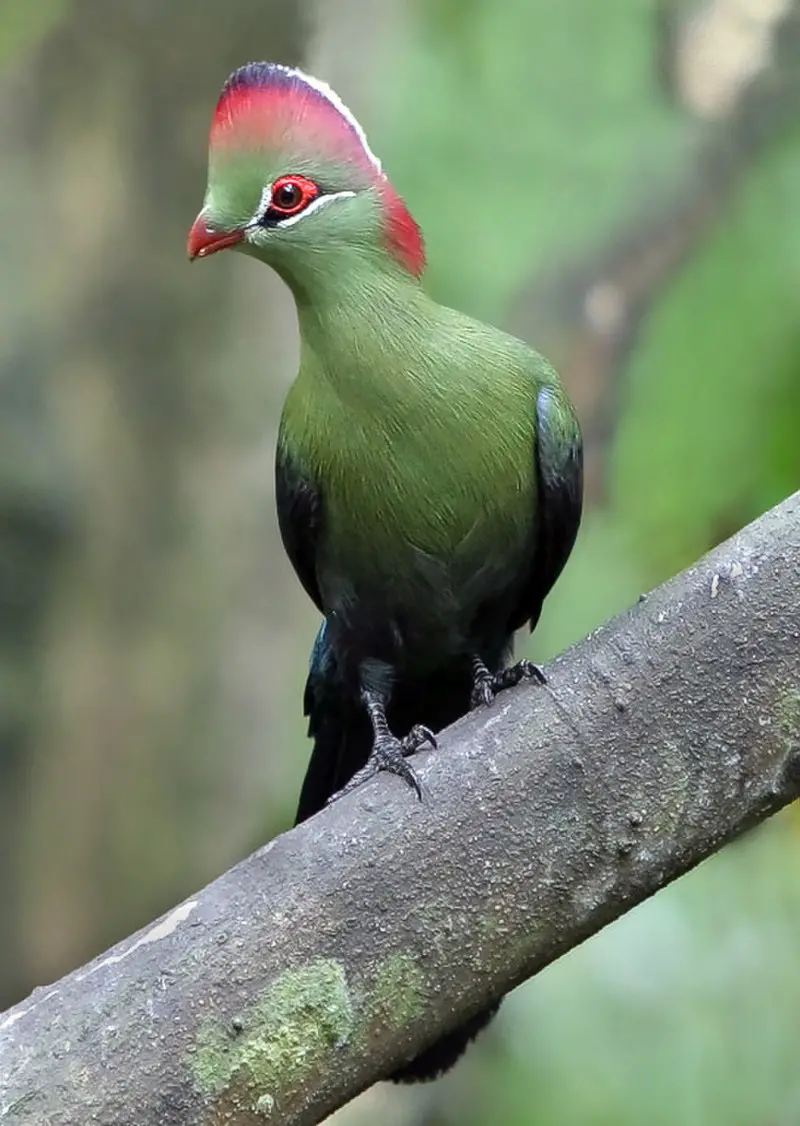
Fischer’s turaco is a beautiful species of bird found in East Africa. It lives in moist lowland and montane forests as well as arable land. Unfortunately, this species is threatened due to habitat loss and trapping for the wildlife trade.
The male Fischer’s Turaco has bright green feathers with blue wings and tail while the female has duller colors, making it easy to identify them apart. This bird also has red eyes which are unique among other birds of its kind.
They feed mainly on fruits from trees or shrubs along with small insects like grasshoppers, beetles, moths etc .
Their diet varies depending on what’s available at any given time but they remain mostly frugivorous throughout their life cycle. With proper conservation efforts we can ensure that these amazing creatures continue to thrive in their natural habitats for years to come.
Scientific classification:
| Kingdom | Animalia |
| Phylum | Chordata |
| Class | Aves |
| Order | Musophagiformes |
| Family | Musophagidae |
| Genus | Tauraco |
| Species | T. fischeri |
25. White-Fronted Bee-Eater
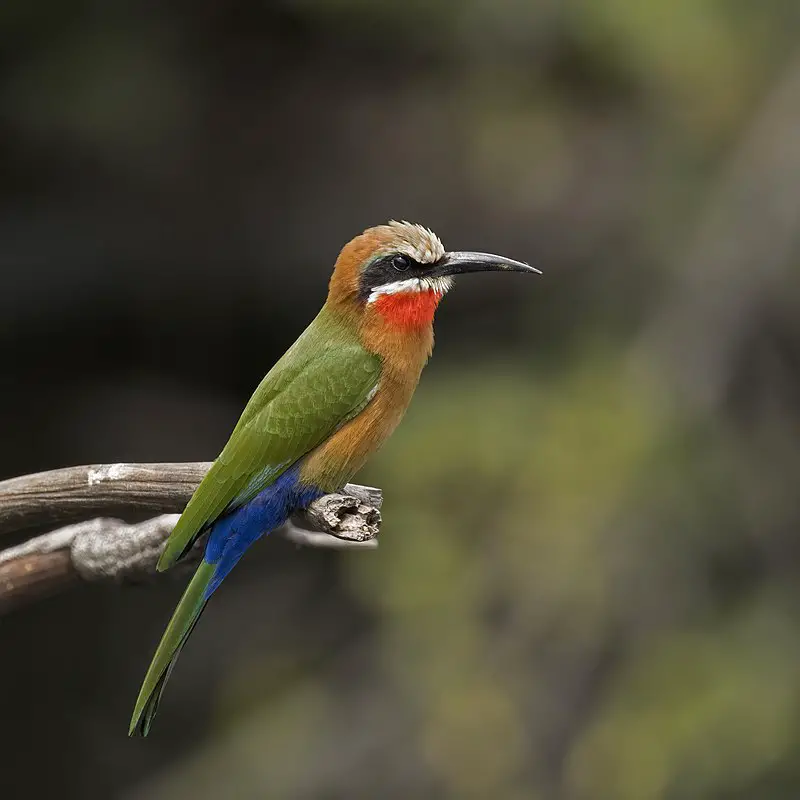
The White-fronted Bee-eater is a beautiful bird native to subequatorial Africa. It has an unmistakable white forehead, square tail and bright red throat patch that sets it apart from other species of bee eaters.
These birds typically nest in colonies by digging holes into cliffs or earthen banks near waterbodies.
During the day they can be seen perched on low trees waiting for passing insects which they swoop down upon with great agility to capture their prey midair.
They may also hover around flowers while searching for food – making them quite a sight to behold indeed.
All in all, these majestic creatures are truly fascinating to observe and make wonderful additions to any natural habitat.
Scientific classification:
| Kingdom | Animalia |
| Phylum | Chordata |
| Class | Aves |
| Order | Coraciiformes |
| Family | Meropidae |
| Genus | Merops |
| Species | M. bullockoides |
26. Sandgrouse
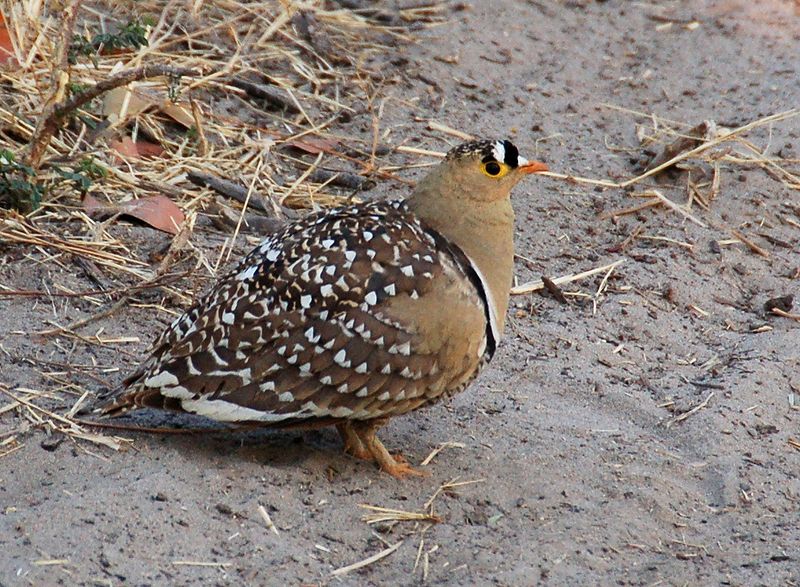
Sandgrouse is birds of the order Pterocliformes, found mainly in Africa and Asia. There are sixteen species belonging to two genera – Syrrhaptes from central Asia and Pterocles from Africa and other Asian countries.
They inhabit treeless areas such as deserts, steppes, scrubland, or savannas and tend to be ground-dwelling birds that feed on seeds.
Sandgrouse has adapted special features for survival in their harsh environment.
They possess well-developed feet with four toes used for walking over hot sand while keeping their body temperature cool at all times by regulating heat loss through their legs.
Their feathers also act like a sponge helping them absorb water before flying long distances back home where they then expel it using specialized glandular secretions located near the wings so that chicks can drink directly from an adult’s breast plumage.
Scientific classification:
| Kingdom | Animalia |
| Phylum | Chordata |
| Class | Aves |
| Clade | Columbimorphae |
| Order | Pterocliformes Huxley, 1868 |
| Family | Pteroclidae Bonaparte, 1831 |
27. Stone-Curlew

Stone-curlews, also known as dikkops or thick-knees, are a family of birds that have adapted to live in tropical and temperate regions throughout the world.
They can be found in Africa, Asia and Australia with two or more species per region. Despite being classified as waders, most prefer dry arid habitats over moist wetlands.
Stone-curlews typically have long legs which help them navigate through their preferred terrain efficiently; some species even stand at an impressive height when standing on those long legs.
Additionally they feature cryptic plumage which helps them blend into their surroundings while hunting for prey such as insects and small mammals like rodents.
These unique bird’s calls are easily recognizable; it has been said that hearing one is similar to listening to someone whistling ‘Keee Weee’.
Scientific classification:
| Kingdom | Animalia |
| Phylum | Chordata |
| Class | Aves |
| Order | Charadriiformes |
| Suborder | Chionidi |
| Family | Burhinidae Mathews, 1912 |
28. Painted-Snipe
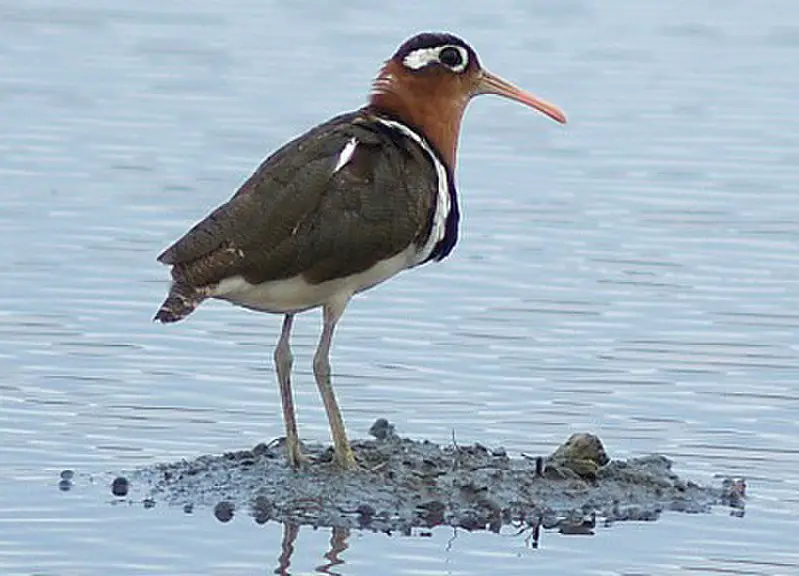
Painted snipes are beautiful and unique wading birds found in the Rostratulidae family. They have short legs, long bills, and a striking plumage which distinguishes them from true snipes.
Males tend to be smaller than females with duller overall coloration. There are three species of painted snipe.
The Greater Painted Snipe, Lesser Painted Snipe, and Australian Painted Snipe – all three have different habitats ranging from wetland pools to grasslands or mangroves depending on their region.
These birds feed mainly on earthworms but also consume insects, crustaceans and plant material when available.
As they rely heavily on wetlands for breeding purposes it is important that we protect these precious habitats so that this special bird can continue to thrive.
Scientific classification:
| Kingdom | Animalia |
| Phylum | Chordata |
| Class | Aves |
| Order | Charadriiformes |
| Suborder | Thinocori |
| Family | Rostratulidae Coues, 1888 |
29. Heliornithidae
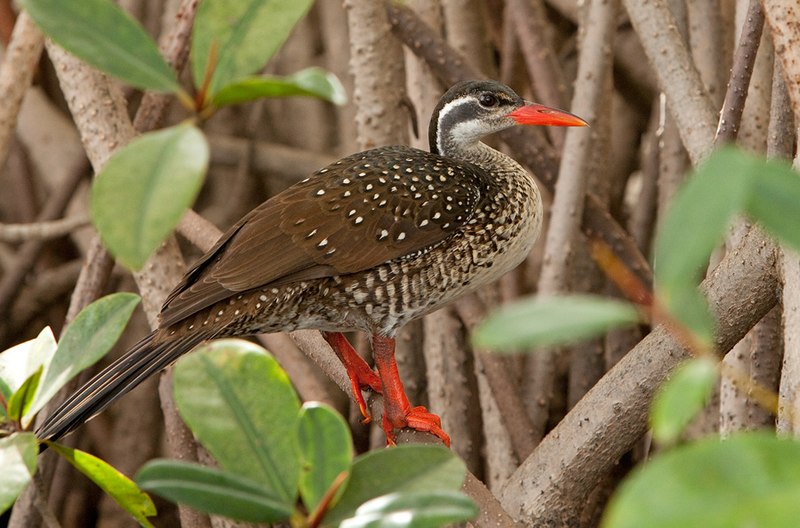
Heliornithidae, commonly known as finfoots, are a small family of tropical birds found in South America and Africa. They have webbed feet like grebes or coots, long necks, slender bodies and broad tails with sharp pointed bills.
Their diverse calls include whistles, squawks and croaks which they use to communicate with each other.
Finfoots feed mainly on fish but also consume insects such as water beetles and dragonflies near the surface of waterbodies.
They nest around rivers or lakes where there is plenty of cover from predators such as eagles or hawks.
During breeding season males can become quite territorial defending their territories against intruders by chasing them off aggressively using loud noises or even physical contact if necessary.
Scientific classification:
| Kingdom | Animalia |
| Phylum | Chordata |
| Class | Aves |
| Order | Gruiformes |
| Family | Heliornithidae GR Gray, 1840 |
30. Plovers

Plovers are a family of around 64-68 species of ground-dwelling birds, commonly found in open country such as fields, meadows and tundras.
They have short bills with webbed feet to help them forage through mud or shallow water.
Plover plumage is usually mottled brown though some species may have brighter colors on the head and wings.
These birds feed mainly on insects but can also eat small crustaceans and worms.
Plovers breed during springtime when they dig holes in sandy or pebbled beaches to lay their eggs which hatch after about 3 weeks incubation period.
They use distraction display behaviour by pretending an injury to the predators away from their nests if needed for protecting their young ones.
Scientific classification:
| Kingdom | Animalia |
| Phylum | Chordata |
| Class | Aves |
| Order | Charadriiformes |
| Family | Charadriidae Leach, 1820 |
31. Glareolidae
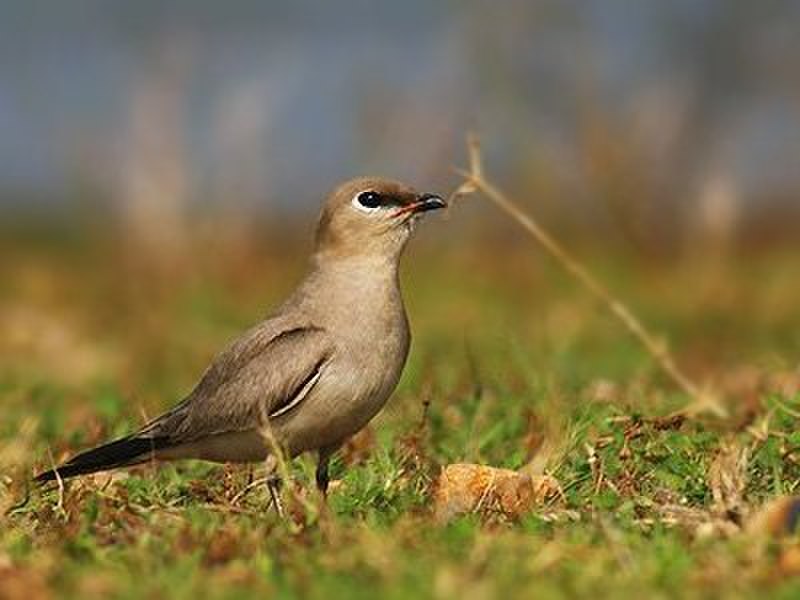
Glareolidae is a family of wading birds, consisting of four genera and 17 species. They are distinguished from other charadrii by their long bills which have a slight downward curve.
Glareolidae live around open grasslands and deserts, where they hunt for insects using the bill to probe into soil or vegetation.
Most species are found in Africa but two pratincoles inhabit parts of Europe and Asia as well.
Coursers tend to be larger than pratincoles with longer legs allowing them to run quickly across sandy dunes while feeding on small animals like lizards or spiders.
Pratincoles feed mainly on flying insects, snatching them out of midair with great agility during flight.
All glareolids share unique features such as large eyes that help it spot prey at night easily making this group one interesting bird family.
Scientific classification:
| Kingdom | Animalia |
| Phylum | Chordata |
| Class | Aves |
| Order | Charadriiformes |
| Suborder | Lari |
| Family | Glareolidae CL Brehm, 1831 |
32. White-Backed Vulture
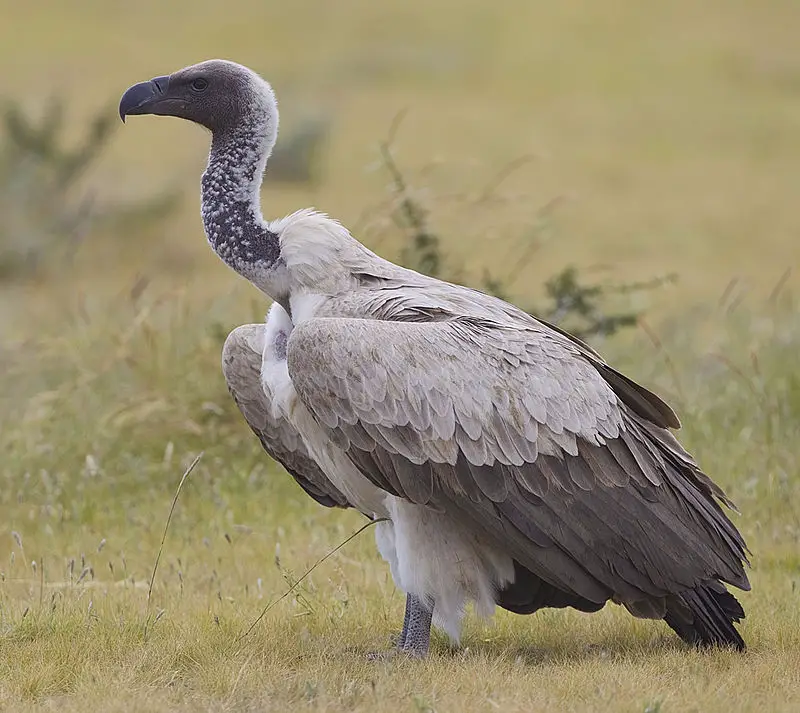
The White-backed Vulture, or Gyps africanus, is a species of Old World vultures that inhabits the African continent.
It has distinct features including down feathers on its head and neck as well as white ruff around its neck. Its wings are broad and its tail short.
This distinctive bird is primarily found in open habitats such as grasslands, savannahs, woodlands and wetlands where it feeds mainly on carrion from animals like wildebeests and zebras killed by other predators.
The White-backed Vulture plays an important role in maintaining balance within the food chain by helping to clean up carcasses left behind by larger carnivores which helps to reduce diseases caused by decaying matter while providing vital nutrients for scavenging birds like itself.
Scientific classification:
| Kingdom | Animalia |
| Phylum | Chordata |
| Class | Aves |
| Order | Accipitriformes |
| Family | Accipitridae |
| Genus | Gyps |
| Species | G. africanus |
Also Featured In: Scavengers Birds You Should Know,
33. Woodland Kingfisher
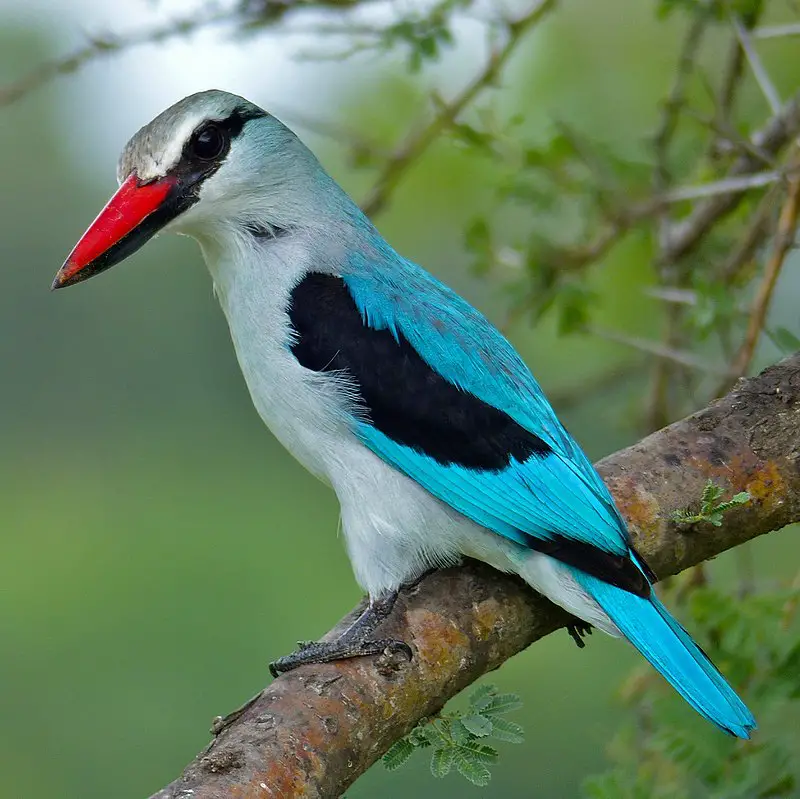
The Woodland Kingfisher is a beautiful bird, native to Africa south of the Sahara. It was first described in 1766 by Carl Linnaeus who called it Alcedo senegalensis.
This tree kingfisher has an attractive blue and white plumage with some red and black markings on its wings, tail and head.
The male also has a bright orange beak which helps to distinguish him from the female whose beak is yellowish-green.
These birds can usually be found in wooded areas near water sources such as rivers or lakes where they hunt for food including fish, frogs, small insects and even lizards.
They build their nests either high up in trees or inside holes dug out of banks near rivers and ponds.
Although not threatened yet, these lovely creatures need our protection so that future generations will have the chance to marvel at them too.
Scientific classification:
| Kingdom | Animalia |
| Phylum | Chordata |
| Class | Aves |
| Order | Coraciiformes |
| Family | Alcedinidae |
| Subfamily | Halcyoninae |
| Genus | Halcyon |
| Species | H. senegalensis |
34. White-Faced Whistling Duck
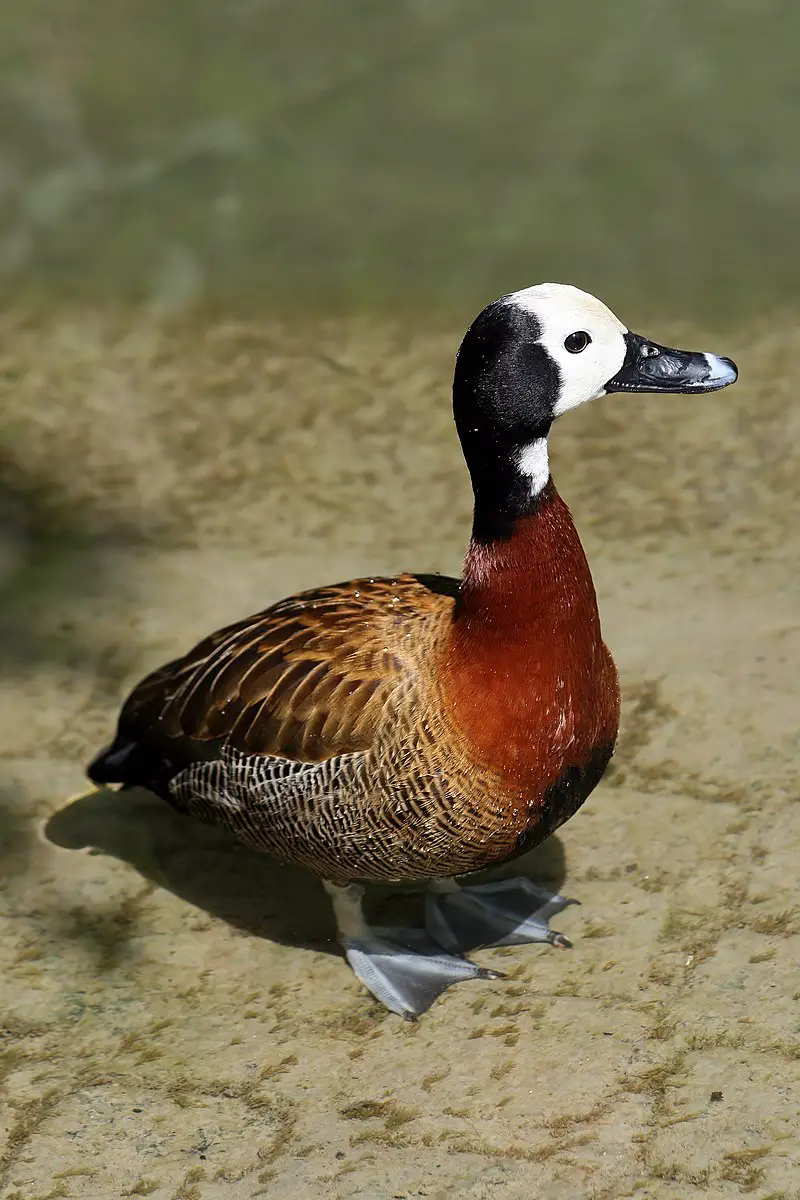
The white-faced whistling duck is a highly social bird native to sub-Saharan Africa and South America. It can be easily identified by its distinct three-note whistling call, as well as its long grey bill.
In the right conditions, it’s not uncommon to spot large flocks of these ducks numbering in the thousands at dawn – an incredible sight.
This species usually lives near bodies of water such as swamps or rivers where they feed on plant matter like grasses and grains which they graze on during the day.
When night falls, they fly off into trees nearby in search of safety from predators before returning to their feeding grounds when morning arrives again.
Scientific classification:
| Kingdom | Animalia |
| Phylum | Chordata |
| Class | Aves |
| Order | Anseriformes |
| Family | Anatidae |
| Genus | Dendrocygna |
| Species | D. viduata |
Also Featured In: Birds You’ll Find in Zoo, Large Birds of Uganda
35. Rufous-Winged Sunbird
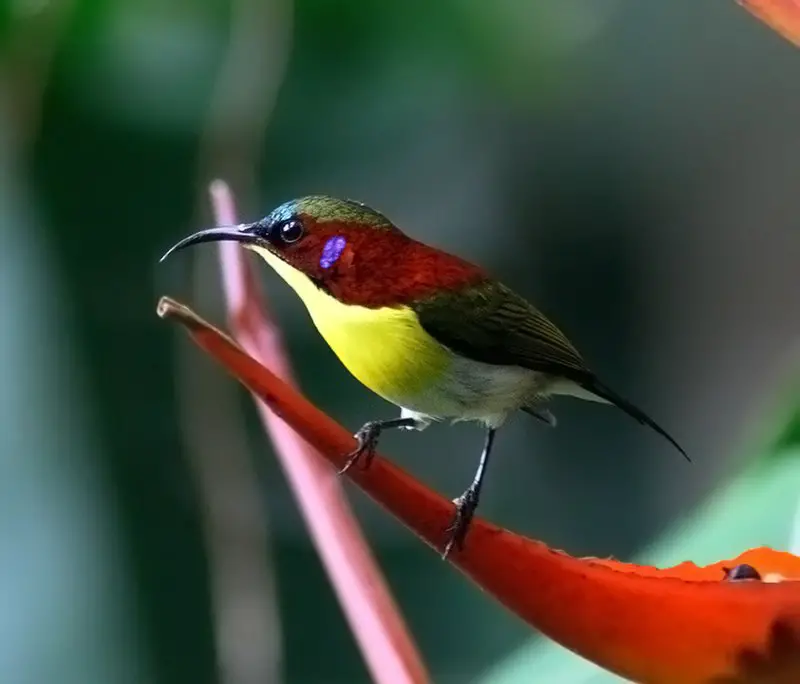
The Rufous-winged Sunbird is a species of bird found in Tanzania. This small vibrant creature has striking orange wings and feathers along its body, making it easily recognizable amongst other birds.
It inhabits subtropical or tropical moist montane forests, but unfortunately this habitat is being threatened by human activities such as deforestation and urbanization which can cause population decline for the sunbird.
As an endemic Tanzanian species, conservation efforts are important to ensure that their populations remain stable so they may continue to inhabit these areas without fear of extinction.
Scientific classification:
| Kingdom | Animalia |
| Phylum | Chordata |
| Class | Aves |
| Order | Passeriformes |
| Family | Nectariniidae |
| Genus | Cinnyris |
| Species | C. rufipennis |
36. Uluguru Bushshrike
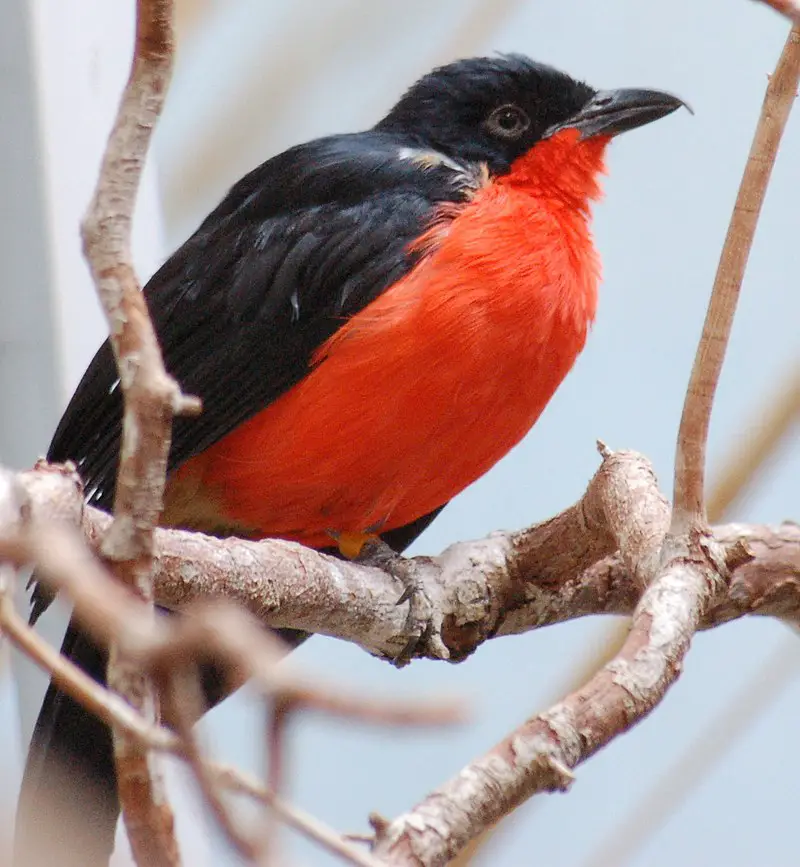
The Uluguru bushshrike is an incredibly rare bird found only in the Uluguru Mountains of Tanzania. It was discovered back in 1926 and was believed to be limited to a single site, within 84km2 of forest reserve.
In 2007, however, the Wildlife Conservation Society of Tanzania made a remarkable discovery; they had located this species outside its original range.
This unique creature has brown upperparts with white spotting on them as well as pale yellow underparts.
Its tail feathers are blackish-brown tipped with white which can be seen when it takes flight – something that unfortunately isn’t witnessed very often due to its rarity.
Scientific classification:
| Kingdom | Animalia |
| Phylum | Chordata |
| Class | Aves |
| Order | Passeriformes |
| Family | Malaconotidae |
| Genus | Malaconotus |
| Species | M. alius |
37. Narina Trogon
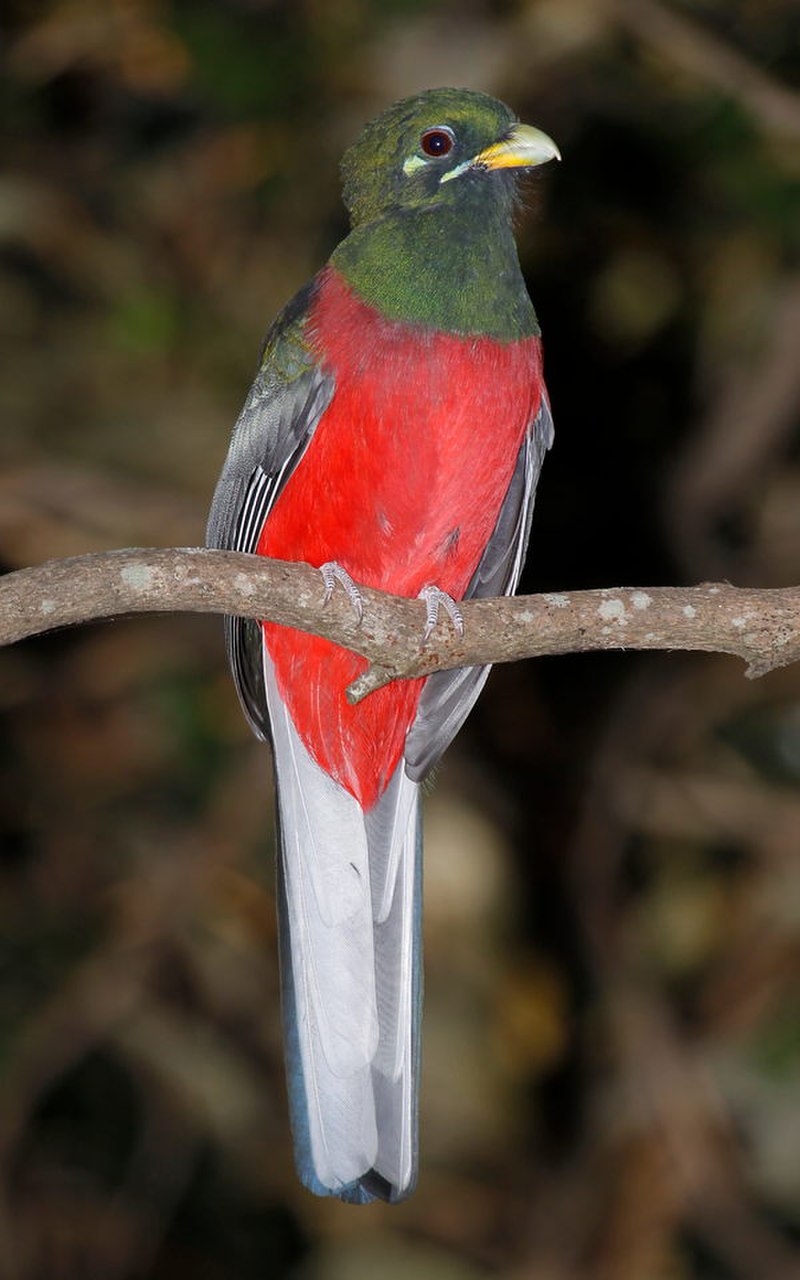
The Narina trogon is a beautiful bird native to forests and woodlands in the Afrotropics. It has a vibrant green head, chestnut neck with white feathers on its throat, bright red underparts and two long tail streamers tipped with black.
An average size of 32-34 cm makes it medium sized among other trogons species.
This highly adaptable species can survive in different environments but local populations have drastically decreased due to deforestation.
Some birds are sedentary while some undertake regular migrations from one place to another making them quite widespread across their range.
The Narina Trogon is an amazing sight for any nature enthusiast as they enjoy fluttering through the forest canopy.
Scientific classification:
| Kingdom | Animalia |
| Phylum | Chordata |
| Class | Aves |
| Order | Trogoniformes |
| Family | Trogonidae |
| Genus | Apaloderma |
| Species | A. narina |
38. Dark Chanting Goshawk
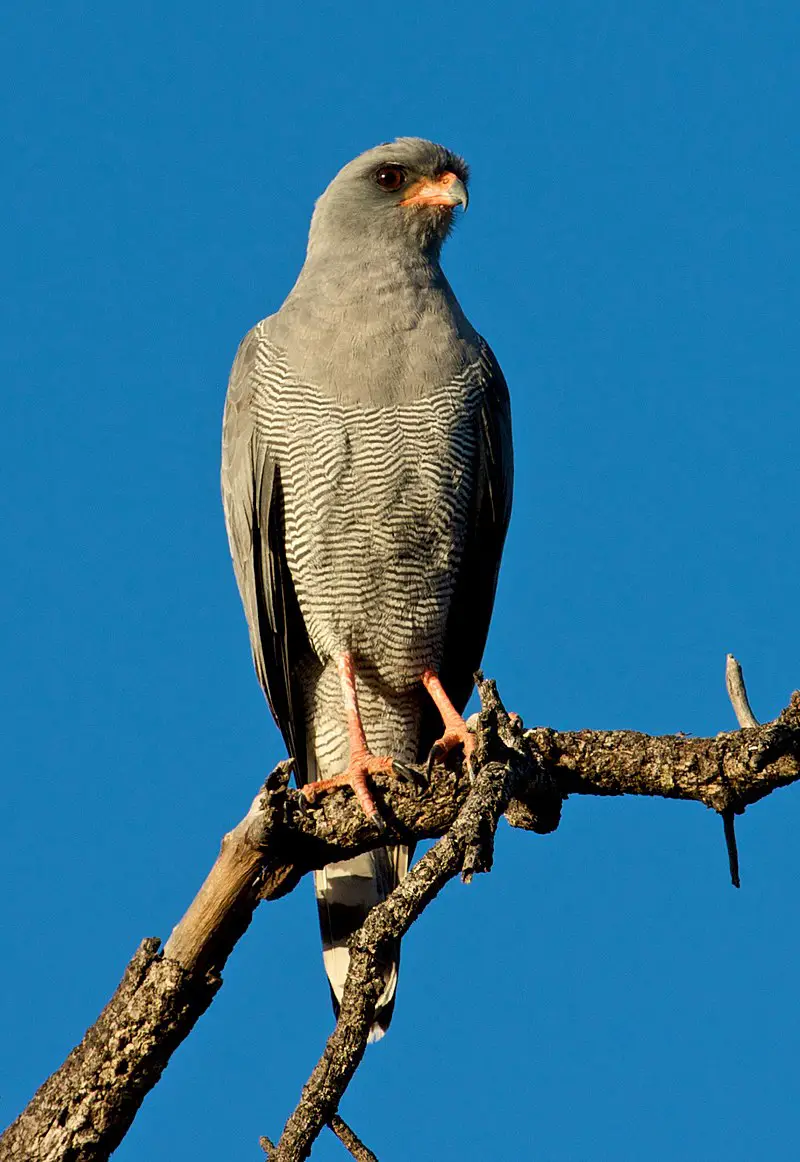
The Dark Chanting Goshawk is a bird of prey found across much of sub-Saharan Africa and Southern Arabia. This medium-sized, bulky hawk has an upright stance with dark grey head, breast, and upperparts contrasted by lighter underparts.
Its long wings have white patches on the underside near the tips. It mainly feeds on small mammals such as rodents but will also hunt birds or reptiles when needed. The goshawk can be seen soaring in open areas searching for its next meal.
They are solitary hunters that prefer to nest high up in tall trees where they can keep watch over their territory from above.
Though these hawks remain relatively common throughout most of their range, there is an isolated population declining in southern Morocco due to urbanization destroying their habitat; making conservation efforts all the more important.
Scientific classification:
| Kingdom | Animalia |
| Phylum | Chordata |
| Class | Aves |
| Order | Accipitriformes |
| Family | Accipitridae |
| Genus | Melierax |
| Species | M. metabates |
39. Black Crake
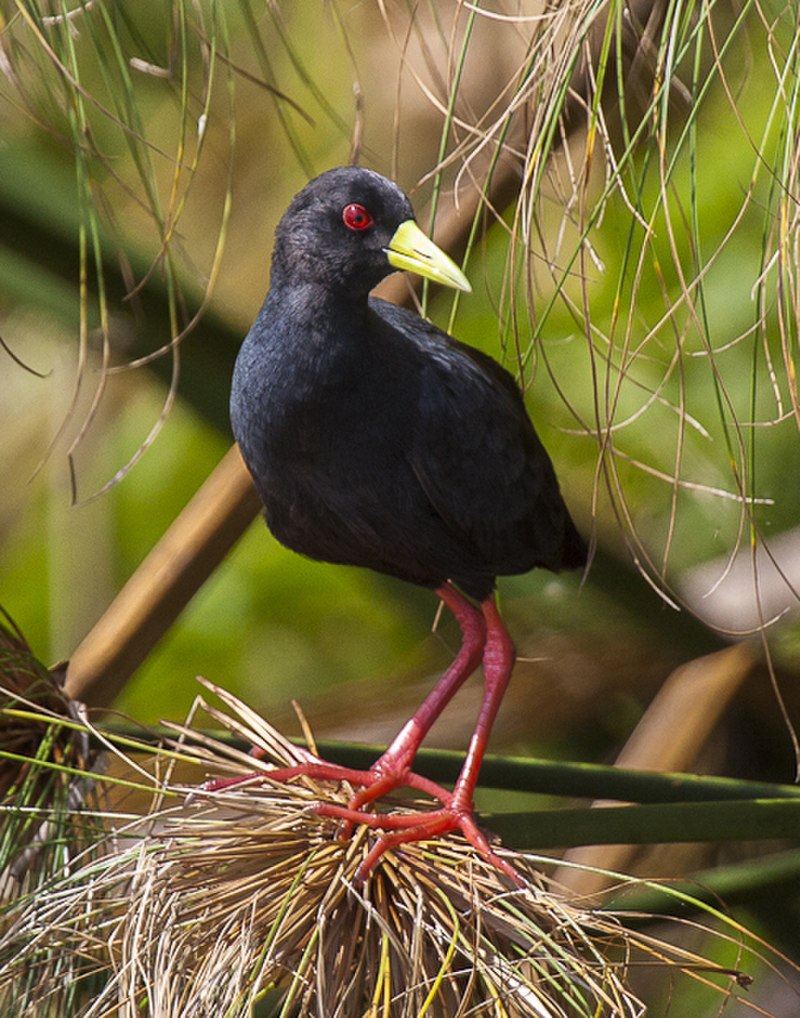
The Black Crake is a beautiful waterbird found throughout most of sub-Saharan Africa. It has no distinct subspecies and shows some seasonal movements in areas affected by drought.
This species was first named “Rallus niger” by J.F Gmelin back in 1788, though it goes by many other names now too.
The black crake has striking yellow legs and bill as well as chestnut brown wings which contrast beautifully with its dark grey body feathers.
They are known to inhabit shallow freshwater wetlands such as marshlands, ponds or lakes where they feed on insects, molluscs and crustaceans amongst others.
All in all the black crake makes an attractive addition to any wetland environment.
Scientific classification:
| Kingdom | Animalia |
| Phylum | Chordata |
| Class | Aves |
| Order | Gruiformes |
| Family | Rallidae |
| Genus | Zapornia |
| Species | Z. flavirostra |
40. Malachite Kingfisher
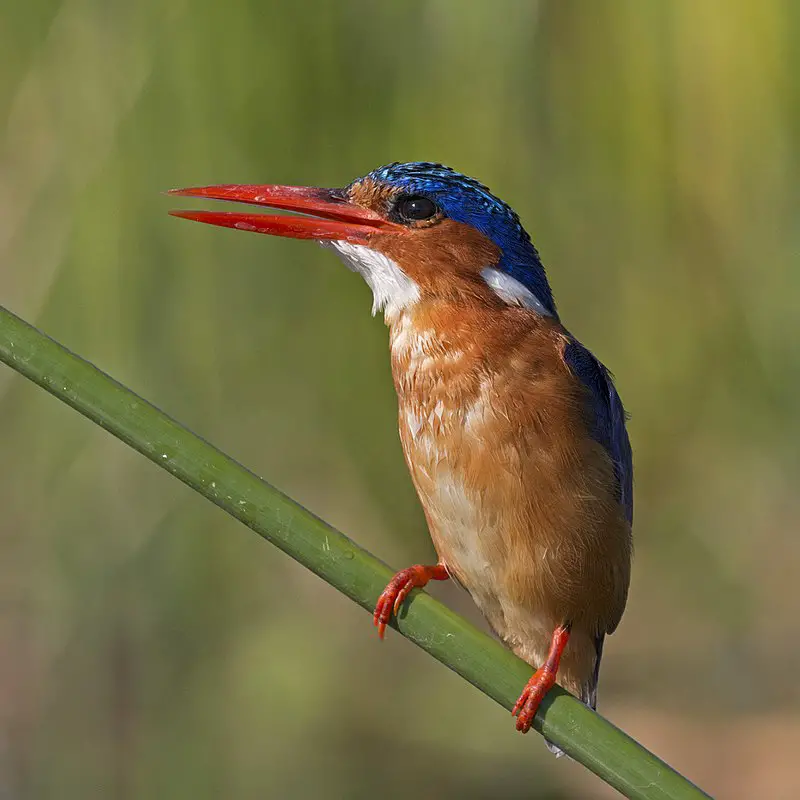
The Malachite Kingfisher is a beautiful bird found in Africa south of the Sahara. It has bright blue wings and tail, with greenish-black upperparts, white chin and breast and orange lower belly.
The species was first described by German naturalist Peter Simon Pallas in 1764 who gave it its binomial name “Alcedo cristata”.
This kingfisher typically inhabits rivers where it feeds on fish, frogs as well as aquatic invertebrates like crustaceans and insects.
Although mainly resident throughout the year, some do make seasonal movements due to climate changes.
These birds are monogamous during breeding season which usually lasts from August till October when they build their nests inside river banks or overhanging vegetation near water bodies.
Scientific classification:
| Kingdom | Animalia |
| Phylum | Chordata |
| Class | Aves |
| Order | Coraciiformes |
| Family | Alcedinidae |
| Subfamily | Alcedininae |
| Genus | Corythornis |
| Species | C. cristatus |
Also Featured In: Birds that Live in lake Mburo National Park,
41. Montane Nightjar
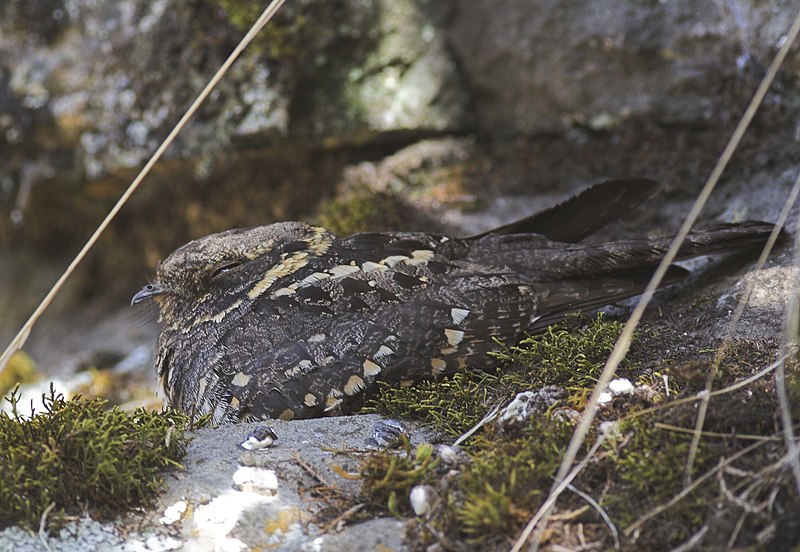
The Montane nightjar is a species of bird found in central and eastern Africa, living in upland regions. It was first described by German naturalist Eduard Rüppell back in 1840 under the scientific name Caprimulgus poliocephalus.
This medium-sized nocturnal bird has mottled greyish brown plumage with white spots on its wings and tail feathers, along with a distinctive black cap on top of its head that gives it the nickname “Abyssinian Nightjar”.
The montane nightjar feeds on insects during the evening hours but can also be seen perched atop trees or shrubs during daytime when they’re resting or basking in sunlight.
They are quite common throughout their range and make an interesting sight for any birder.
Scientific classification:
| Kingdom | Animalia |
| Phylum | Chordata |
| Class | Aves |
| Order | Caprimulgiformes |
| Family | Caprimulgidae |
| Genus | Caprimulgus |
| Species | C. poliocephalus |
42. Pemba Green Pigeon
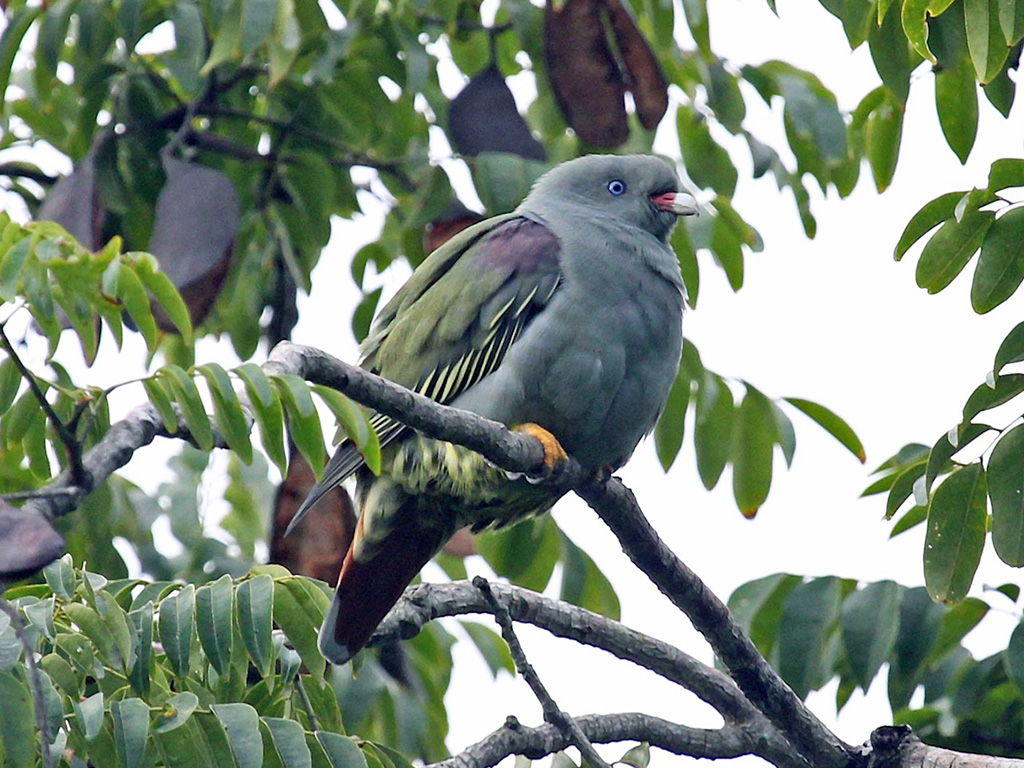
The Pemba green pigeon is a species of bird belonging to the Columbidae family and endemic to Tanzania. It can be found in lowland forests, plantations, rural gardens and other similar habitats.
Sadly, this beautiful bird is threatened by habitat loss due mainly to deforestation activities taking place throughout its range. The adult has an overall grey-green colouration with wings that have blackish tips on the feathers; it also has a white band across its chest and blue legs.
This species feeds mostly on fruits such as figs but will also eat seeds when needed for sustenance during dryer periods in their environment. Conservation efforts are essential if we want future generations to enjoy seeing this attractive little creature thrive in its natural environment again.
Scientific classification:
| Kingdom | Animalia |
| Phylum | Chordata |
| Class | Aves |
| Order | Columbiformes |
| Family | Columbidae |
| Genus | Treron |
| Species | T. pembaensis |
43. Kilombero Weaver
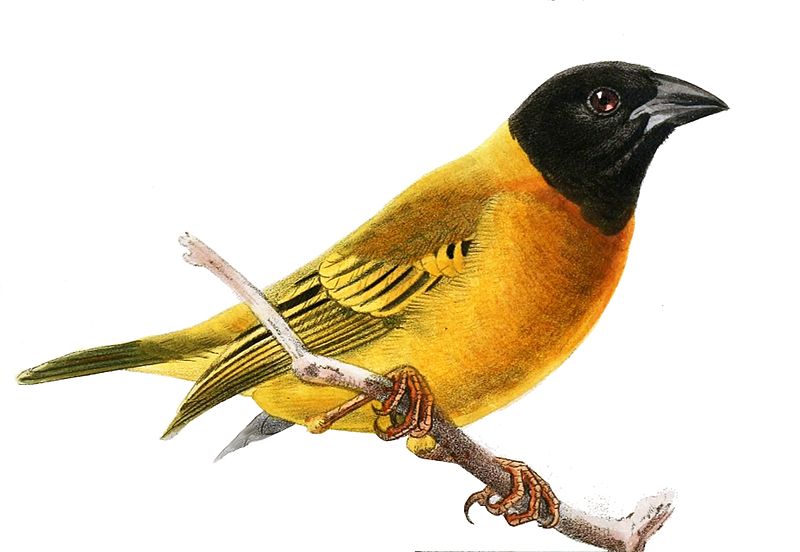
The Kilombero weaver is a beautiful species of bird belonging to the Ploceidae family. It is endemic only in Tanzania and inhabits swamps, making it dependent on this environment for its survival.
Unfortunately, this habitat loss has led to a decrease in numbers and put them at risk of extinction unless something can be done about it soon. The male sports an impressive plumage with bright yellow head feathers mixed with chestnut colour wings and tail; while females are duller but no less attractive.
They nest close together near water sources build complex nests from reeds which they weave together using their specialised bill creating one big structure that other birds may use as well when breeding season comes around again each year.
Scientific classification:
| Kingdom | Animalia |
| Phylum | Chordata |
| Class | Aves |
| Order | Passeriformes |
| Family | Ploceidae |
| Genus | Ploceus |
| Species | P. burnieri |
44. Southern Red Bishop
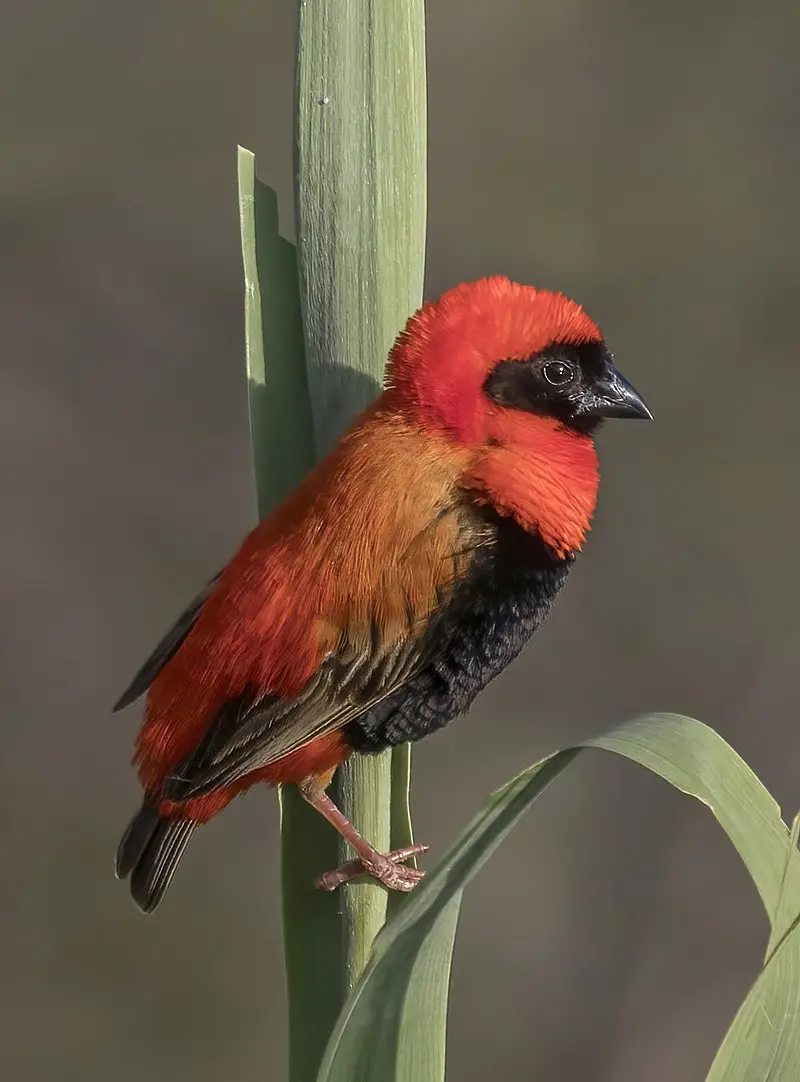
The Southern Red Bishop, also known as the red bishop, is a small passerine bird that can be found in wetlands and grasslands south of the equator. It belongs to the Ploceidae family and its genus Euplectes.
This species has bright red plumage with black wings, tail feathers, face mask and bill on males while females are mostly brown in colour with faint streaks across their breast region.
The male birds have yellow eyes while female’s eye color ranges from light orange to deep reddish-brown tones depending on age or season.
They feed mainly on seeds but will occasionally eat insects such as termites and beetles when they’re available too.
These birds form flocks during nonbreeding periods which makes them easier to spot since you’ll likely see more than one at once.
Scientific classification:
| Kingdom | Animalia |
| Phylum | Chordata |
| Class | Aves |
| Order | Passeriformes |
| Family | Ploceidae |
| Genus | Euplectes |
| Species | E. orix |
Also Featured In: Johannesburg Birds You Need to Know,
45. Blacksmith Lapwing
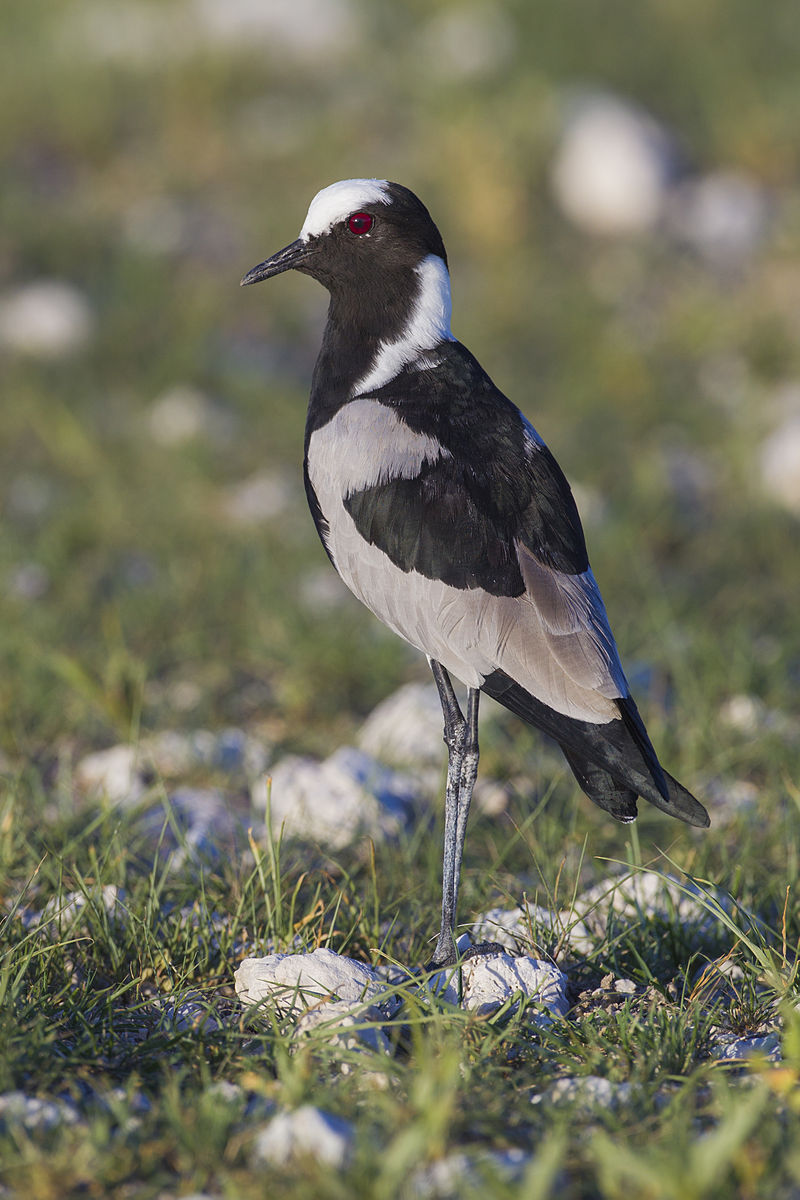
The Blacksmith lapwing is a bird that has an unique appearance with black, grey and white colors. It can be found in Kenya through central Tanzania to south Africa.
The name of the species comes from its alarm call which resembles the sound of a blacksmith striking an anvil – “tink, tink, tink.”.
These birds are quite common but their numbers have been declining due to habitat destruction caused by human activities such as urbanization and agriculture expansion.
They build nests on open ground like grasslands or scrubland near water sources where they feed on insects and small invertebrates while also being preyed upon by larger animals like mongooses or snakes.
Conservation efforts must be taken in order protect these beautiful creatures so future generations can admire them too.
Scientific classification:
| Kingdom | Animalia |
| Phylum | Chordata |
| Class | Aves |
| Order | Charadriiformes |
| Family | Charadriidae |
| Genus | Vanellus |
| Species | V. armatus |
Also Featured In: Birds of Etosha National Park,
46. Crowned Lapwing
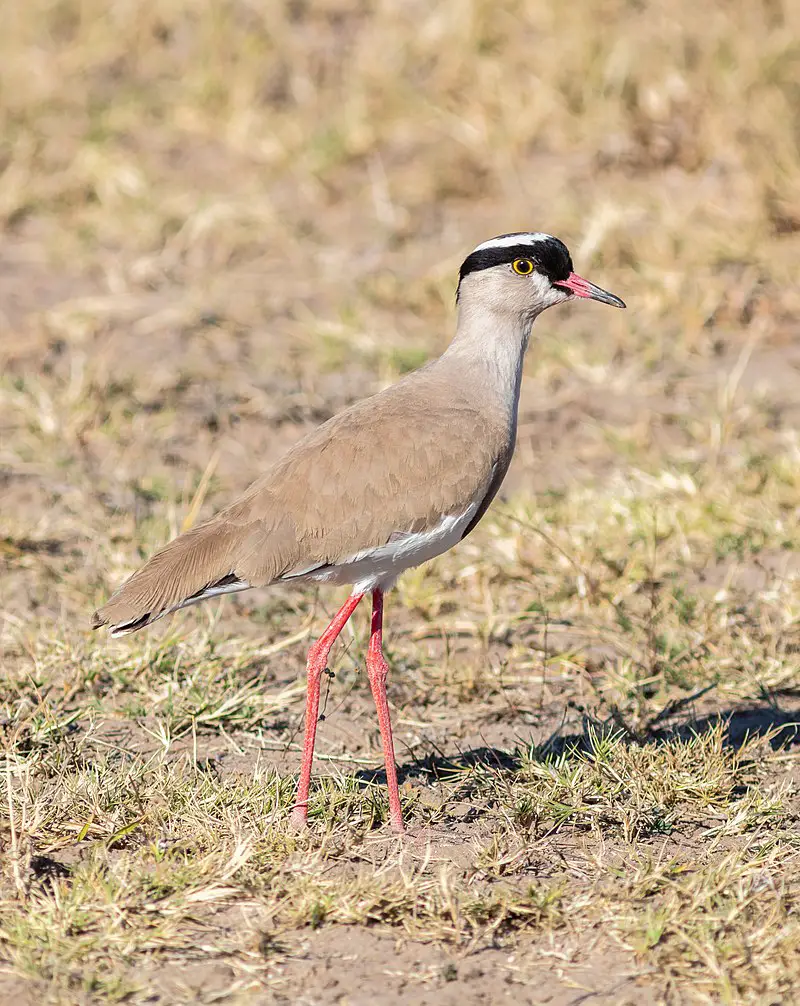
The crowned lapwing is a striking bird of the subfamily Vanellinae, found in many parts of Africa. Their most distinctive feature is their bright and attractive crown-shaped crest on the head.
They typically have brown plumage with white spots over the wings and tail, as well as yellow legs and beaks.
These birds are known for being quite vocal; they make loud calls to communicate between one another or warn predators away from their nests.
Crowned lapwings can live up to 10 years in captivity but usually only survive 1–2 years in the wild due to predation by other animals such as cats, dogs, snakes and hawks.
Despite this mortality rate these birds remain common throughout much of Africa thanks to their adaptability and ability nest near humans without conflict.
Scientific classification:
| Kingdom | Animalia |
| Phylum | Chordata |
| Class | Aves |
| Order | Charadriiformes |
| Family | Charadriidae |
| Genus | Vanellus |
| Species | V. coronatus |
47. Zanzibar Red Bishop
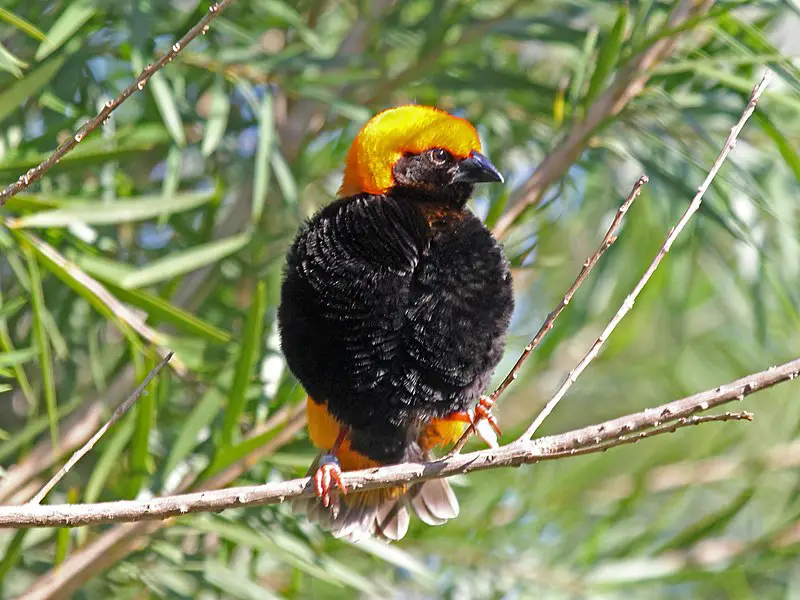
The Zanzibar red bishop is a vibrant species of bird found in Kenya, Mozambique and Tanzania.
It belongs to the Ploceidae family and features eye-catching black plumage on its head, chest and back while having striking orange feathers decorating its wings, tail and abdomen.
This makes it easily recognizable among other birds in the region.
The beak is medium sized with an ivory coloration which helps it feed more efficiently on small insects like larvae as well as grains such as millet or sorghum seeds during dry seasons when food sources are scarce.
Its call is quite distinct; a low ‘tuk-tuk’ sound that can often be heard echoing throughout African plains late into the night.
Overall this stunningly colored creature brings beauty to Africa’s vast landscape making it one of nature’s true marvels.
Scientific classification:
| Kingdom | Animalia |
| Phylum | Chordata |
| Class | Aves |
| Order | Passeriformes |
| Family | Ploceidae |
| Genus | Euplectes |
| Species | E. nigroventris |
48. Banded Green Sunbird
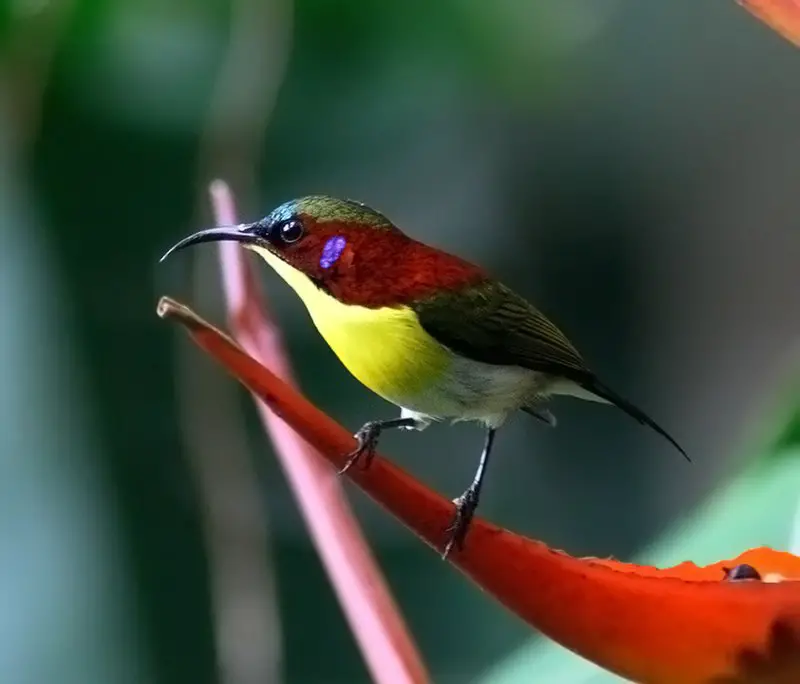
The Banded green sunbird is a species of bird that belongs to the Nectariniidae family and is native to Tanzania. Due to human activities, the natural habitats of these birds are slowly getting destroyed which makes them vulnerable to extinction.
These birds prefer subtropical or tropical moist lowland forests, montane forests, plantations as well as rural gardens for their habitat. This brightly coloured songbird has distinctive red legs and bill with white bars on its wings making it quite unique in appearance.
The banded green sunbirds live in small flocks throughout the year where they feed upon nectars from flowers while also taking insects and spiders occasionally too. Therefore it plays an important role by helping in pollination process due to its fondness towards bright-coloured flowers like hibiscus etc., thus providing balance within our ecosystems.
Scientific classification:
| Kingdom | Animalia |
| Phylum | Chordata |
| Class | Aves |
| Order | Passeriformes |
| Family | Nectariniidae |
| Genus | Anthreptes |
| Species | A. rubritorques |
49. Moreau’s Sunbird
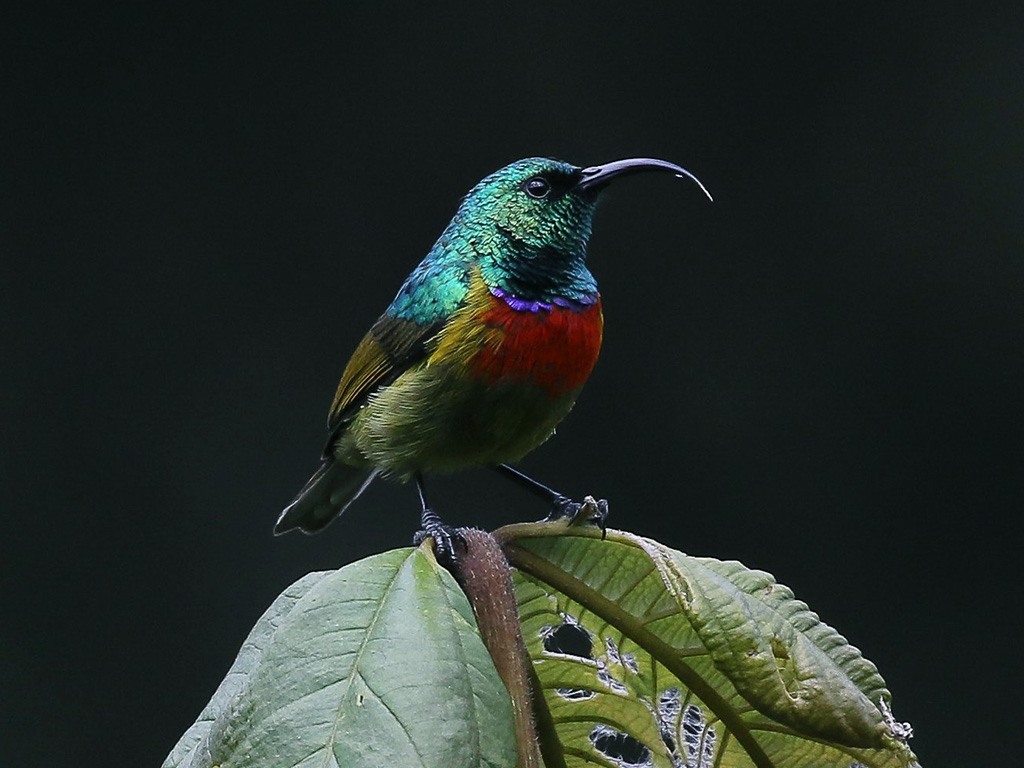
Moreau’s sunbird is a species of bird native to Tanzania. It inhabits subtropical and tropical moist montane forests, however it is threatened by habitat loss and has been classified as near-threatened by the International Union for Conservation of Nature (IUCN).
This small species grows up to 12 cm in length with males having an olive green head, back and breast while its chin and throat are yellowish. Females look similar but have brown upperparts instead.
Its diet mainly consists of nectar from flowers which they obtain using their long curved beaks adapted specifically for this purpose.
The conservation status of Moreau’s Sunbirds needs attention as these birds play an important role in pollinating plants within their habitats.
Scientific classification:
| Kingdom | Animalia |
| Phylum | Chordata |
| Class | Aves |
| Order | Passeriformes |
| Family | Nectariniidae |
| Genus | Cinnyris |
| Species | C. moreaui |
50. African Paradise Flycatcher
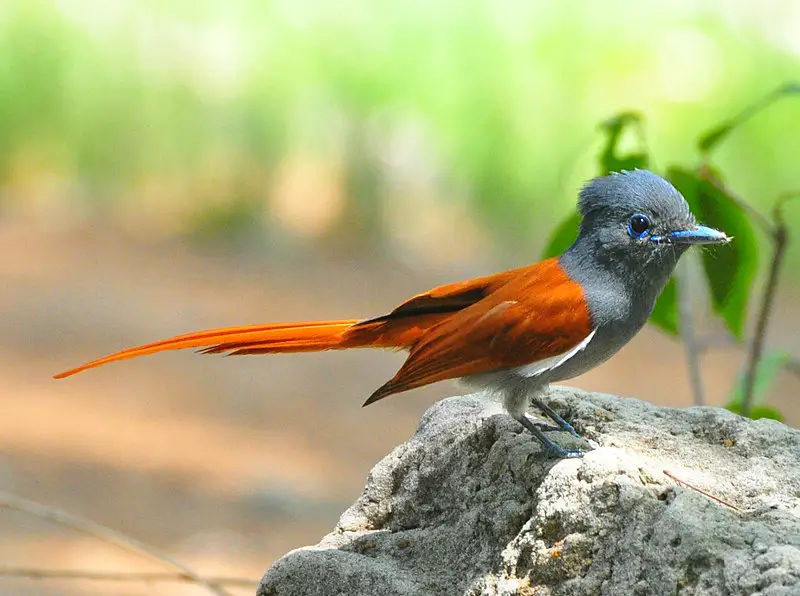
The African paradise flycatcher is a beautiful passerine bird, with the males having tail feathers that extend into streamers twice as long as its body.
Males have chestnut or rusty coloured upper parts on their wings and tails, contrasting nicely against the whitish underparts of both genders.
The head and throat are black for adult males, while females lack this colouration but feature some orange-red streaking instead.
Both sexes bear red eyes and blue-grey legs and feet to round out their appearance.
These birds mainly inhabit tropical forests throughout Sub-Saharan Africa where they feed primarily on insects such as beetles, ants, cicadas; occasionally supplementing it with small fruit when available during certain times of year.
Scientific classification:
| Kingdom | Animalia |
| Phylum | Chordata |
| Class | Aves |
| Order | Passeriformes |
| Family | Monarchidae |
| Genus | Terpsiphone |
| Species | T. viridis |